

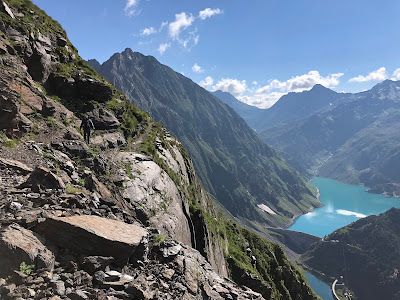
![[Ranunculaceae] Ranunculus aconitifolius – Aconite-Leaf Buttercup (Ranuncolo a foglie di aconito) along the trail. [Ranunculaceae] Ranunculus aconitifolius – Aconite-Leaf Buttercup (Ranuncolo a foglie di aconito) along the trail.](https://blogger.googleusercontent.com/img/b/R29vZ2xl/AVvXsEi47NLR9U3mbQoZ9H-iqBUQ_X0F3o2EZSu9rpt7zl63wLF6HsehVl8d2SVYo_yPhR8znrBxDJmk32DWPGmRPf2gFN-xToYzVPdJlPIjpBoW-3vJjFuC13aMIxxdMA6oO6z2hHyu3mJvjQ/s400/%255BRanunculaceae%255D+Ranunculus+aconitifolius.jpg)
Upper Left: The clockwise Sentiero delle Orobie route followed, starting and ending at Ardesio.
Upper Right: On the edge of Laghi Gemelli (day 1).
Lower Left: On the trail to Rifugio Curò with Reservoir of Barbellino visible (day 5).
Lower Right: [Ranunculaceae] Ranunculus aconitifolius – Aconite-Leaf Buttercup (Ranuncolo a foglie di aconito) along the trail.
Overview
Length: 90.4 km (56 mi)
Duration: 39.4 hours walking time
Elevation: Minimum at Ardesio 780 m (2,559 ft) and maximum
at Ol Simal 2712 m (8,898 ft)
Location: Italy, Lombardy, Bergamo, Bergamasque
Prealps (Valbondione, Valle Seriana)
Itinerary - Day-by-Day Breakdown
[ ] - predicted by guide books and web sites
{ } - what we recorded
Day 1
Valcanale – Bus stop Babes (1000 m) -> Rifugio Alpe Corte (1410 m) -> Rifugio Laghi Gemelli (1968 m)
Sentiero 220
from Valcanale to Rifugio Alpe Corte [2 km / 0.75 h]
Sentiero 216
from Rifugio Alpe Corte to Rifugio Lago Gemelli [5.5 km / 3 h]
Notes: We did not stay at Rifugio Alpe Corte. If you decide to walk from Ardesio to Valcanale (the first part of Sentiero 220), you might want to spend the night at Alpe Corte. More typical, is to take the bus like we did from Ardesio to Valcanale and then start the hike. In this case, from Valcanale to Alpe Corte is less than an hour and not worth stopping for the night.
{8.9 km / 3.75 h / + 1280 m / - 390 m / max 2130 m / min 1280 m}




Views of day 1. Left: Trail just above Rifugio Alpe Corte. Center Left: Approaching Passo di Laghi Gemelli. Center Right: View of Laghi Gemelli from the pass and with the rifugio at the far end of the lakes. Right: Laghi Gemelli in the early evening.
Day 2
Sentiero 213
[12 km / 3.75 h]
{12.3 km / 4.9 h / + 1165 m / - 1124 m / max 2000 m / min
1721 m}




Views of day 2: Left: On the trail 213 above Carona on the way to Rifugio Calvi. Center Left: Trail 213 goes through several tunnels like this one. Center Right: Lago Sardegnana and artificial basin important in the generation of hydroelectric energy, operated by ENEL. Right: Walking in the mist and flowers. The only day we got a little rain.




Views of day 2: Left: On the trail 213 above Carona on the way to Rifugio Calvi. Center Left: Trail 213 goes through several tunnels like this one. Center Right: Lago Sardegnana and artificial basin important in the generation of hydroelectric energy, operated by ENEL. Right: Walking in the mist and flowers. The only day we got a little rain.
Day 3
Rifugio Calvi (2015 m) -> Rifugio Baroni al Brunone (2297 m)
Sentiero 225
[10.5 km / 5 h ]
{11.4 km / 5.5 h / + 1369 m / - 1105 m / max 2496 m / min
1935 m}




Views of day 3. Left: Starting off for Brunone and looking back on Rifugio Calvi with Monte Cabianca in the background. Center Left: Trail 225 near Monte Grabiasca. Center Right: Approaching Passo di Valsecca, the northernmost connection between the Valle Brembana and the Valle Seriana. Right: Just over the Passo di Valsecca and heading toward Bivacco Frattini (orange structure in photo).




Views of day 3. Left: Starting off for Brunone and looking back on Rifugio Calvi with Monte Cabianca in the background. Center Left: Trail 225 near Monte Grabiasca. Center Right: Approaching Passo di Valsecca, the northernmost connection between the Valle Brembana and the Valle Seriana. Right: Just over the Passo di Valsecca and heading toward Bivacco Frattini (orange structure in photo).
Day 4
Sentiero 302
[6 km / 4.5 h ]
{no data :-( }


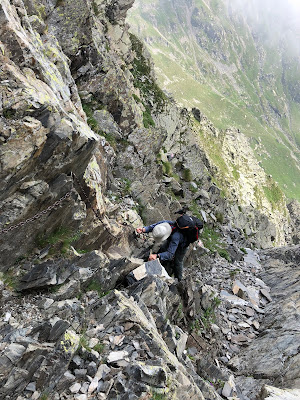


Views of day 4. Left: Vedretta dei secreti along trail 302. Vedretta is small glacier in a cirque. Center Left: Descending a steep part just after Ol Simal and heading to Coca. Center: Another steep part just above Lago di Coca. Center Right: Lago di Coca in view. Right: Rifugio Coca dead ahead.





Views of day 4. Left: Vedretta dei secreti along trail 302. Vedretta is small glacier in a cirque. Center Left: Descending a steep part just after Ol Simal and heading to Coca. Center: Another steep part just above Lago di Coca. Center Right: Lago di Coca in view. Right: Rifugio Coca dead ahead.
Day 5
Rifugio Coca (1892 m) -> Rifugio Antonio Curò (1915 m)
Sentiero 303 [5.8
km / 2.75 h ]
Side trip: Rifugio Curò (1915 m) -> Rifugio Barbellino (2129 m)
Sentiero 308
[9.7 km roundtrip from Curò]
Notes: We stayed in the Ostello at Curò. Check-in for the ostello (hostel in English) is still at the rifugio. Hostel as a translation doesn't do the Ostello at Curò justice; it's actually quite nice.
{15.5 km total / 6.5 h / + 1880 m / - 1808 m / max 2342 m /
min 1802 m}




Views of day 5. Left: Looking back at Rifugio Coca as we head to Rifugio Curò. Center Left: Typical section of trail 303 heading to Curò. Center Right: Reservoir of Barbellino in view. Right: Trail from Rifugio Curò to Rifugio Barbellino and the Reservoir of Berbellino.




Views of day 5. Left: Looking back at Rifugio Coca as we head to Rifugio Curò. Center Left: Typical section of trail 303 heading to Curò. Center Right: Reservoir of Barbellino in view. Right: Trail from Rifugio Curò to Rifugio Barbellino and the Reservoir of Berbellino.
Day 6
Rifugio Curò (1915 m) -> Passo della Manina (1821 m) - Rifugio Luigi Albani (1939 m)
Sentiero 304 Curò
-> Manina [7.7 km / 2.5 h]
Sentiero 401 Manina
-> Albani [9.7 km / 4.0 h]
{19.8 km / 9.0 h / + 2053 m / - 2004 m / max 2307 m / min
1600 m}




Views of day 6. Left: A church on Passo delle Manina. Center Left: Walking under Monte Vigna Vaga and heading toward Passo di Fontanamora. Center Right: Walking toward Monte Ferrante. Right: Presolana and its famous momentary rose color (called alpenglow) at sunset.




Views of day 6. Left: A church on Passo delle Manina. Center Left: Walking under Monte Vigna Vaga and heading toward Passo di Fontanamora. Center Right: Walking toward Monte Ferrante. Right: Presolana and its famous momentary rose color (called alpenglow) at sunset.
Day 7
Rifugio Albani (1939 m) -> Ardesio (780 m)
Sentiero 311 [16
km / 4:30 h]
Notes: We did not take the trail over Presolana (Sentiero 326). This
part of the trail requires the correct gear and experience with traveling on vie ferrate. Instead,
we returned to Ardesio.
{16.5 km / 5.2 h / + 716 m / - 2051 m / max 2067 m / min 613
m}




Views of day 7. Left: Last view of Presolana as the trail descends. Center Left: Leaving the mountains and coming into farmland above Valzurio. Center Right: Walking in to Ardesio. Right: Like all good Italian trails, a swing by the church.




Views of day 7. Left: Last view of Presolana as the trail descends. Center Left: Leaving the mountains and coming into farmland above Valzurio. Center Right: Walking in to Ardesio. Right: Like all good Italian trails, a swing by the church.
Total
{90.4 km / 39.4 h} -> average speed of 2.29 km/hr
{56 mi / 39.4 h} -> average speed of 1.42 mi/hr
Notes on Itinerary
- The links to trails and rifugi take you to CAI Bergamo site. There you can select English to read trail descriptions as well as download tracks. The tracks are good, but not exact. While we were walking, we noted the downloaded tracks left off many curves and twists and turns of the trail.
- We downloaded all the tracks for offline use in Maps.me, which is the offline mapping program we use the most. Maps.me worked flawlessly for helping us make sure we were going in the right direction, especially at forks in the trail. (Make sure to download the maps for the areas of interest before you leave on your trip.) If we didn’t have Maps.me (or some other offline application), we would have completed the hike as well but perhaps with a lot more concentration on the trail signage and perhaps a few more mistakes. Having the tracks loaded ahead of time helped us correct quickly after a mistake. Addendum 2024: Maps.me has become a nightmare to use, we switched to Outdoor Active.
- The values in square brackets above are [length in kilometers, time in hours]. The times are from the CAI pages for each trail. The lengths are calculated from importing the tracks into Google Maps and then looking at what Google calculates. That said, these lengths and times are just approximations. We found that our times were longer due to picture taking, stopping to enjoy the scenery, an occasional snack, etc. As well our distances were longer, probably due to the CAI tracks not accounting for the trail precisely.
- The values in curly brackets are what we calculated from a GPS tracker (View Ranger): {length in kilometers / time in hours / total elevation gain in meters / total elevation loss in meters / maximum elevation reached in meters / minimum elevation gain reached in meters}The times we recorded are walking times and don’t include stops.
FAQ About the Hike
Where exactly is this hike?
The Sentiero delle
Orobie trail is northeast of Bergamo and takes trekkers along part of upper
Valle Brembana and Valle Seriana. These valleys are in the Bergamo Alps, a
mountain range that is part of the larger Italian Alps.
You spend much of the hike at 2000 m (6,500 ft) and above taking in spectacular
scenery. The highest peak in the Bergamo Alps is Pizzo Coco at 3052 m (10,014
ft).
Why is the hike special?
This hike is a sort of rite of passage for Bergamaschi. We’ve heard it talked about for so long and
were interested in experiencing it. Bergamo – the city – is at the head of the
two valleys Val Brembana and Val Seriana that figure important in the city’s
history. This hike takes in a little of Val Brembana (first and second day) and
a lot of the Val Seriana, above Valbondione.
People in Bergamo know their mountains, trails and rifugi. They are strongly connected to
the landscape. A good example of this is how strong and well-organized CAI
Bergamo is. Therefore, for us as implants, being able to experience the trail
was another way of becoming just a little more Bergamasco.
Another reason why this hike is special is because it’s
mostly known only by Italians. A few weeks earlier we walked the first and last
part of the Tour du Mont Blanc (TMB) with a friend. (See Hike
from Courmayeur to Rifugio Bonatti and Back and Val
Veny: Hike to Rifugio Elisabetta.) We were struck by how the
composition of the hikers was very international with almost no Italians. It’s just a different hike. If you are
looking for a challenging hike (our friend who did TMB and Sentiero delle Orobie said the TMB was easier) and the ability to share
it with Italians, then Sentiero delle Orobie
may be your ticket.




Views of the Orobie. Left: Laghi Gemelli. Center Left: View of the mountain ranges above Rifugio Brunone visible in the photo. Center Right: Start day on the 6th day from Rifugio Curò to Rifugio Albani. Right: The valley above Lizzola.




Views of the Orobie. Left: Laghi Gemelli. Center Left: View of the mountain ranges above Rifugio Brunone visible in the photo. Center Right: Start day on the 6th day from Rifugio Curò to Rifugio Albani. Right: The valley above Lizzola.
How do I get to the
starting and ending point of the hike from Bergamo?
The start and finish of the hike is reachable by car or
public transportation. Using public transportation, you can reach the start of
the hike at Babes (Valcanale) in three
hops by bus. From Bergamo Terminal S.A.B. (at the main train station), take the
Linea S to Clusone, then Linea S60a to Ardesio, and finally Linea S60b to
Valcanale. That first two buses are blue
and the last a small white van/bus. You can find more information at BergamoTransporti. As an example of timing, we left Bergamo at
7:10 am and arrived at Valcanale at 10:15 am.
Returning from end of the hike back to Bergamo was just two
hops with the bus since we finished at Ardesio. Take Linea s60a from Ardesio to
Clusone and then Linea S from Clusone to Bergamo. (“S” stands for Valle Seriana in which these
buses run.)
What the hike hard? Scary?
Most of the hike takes place around 6,500 ft. (Most of the rifugi are at this altitude.) You go up
and down quite a bit, so you need to be physically fit to handle seven days of
walking with lots of altitude gain and loss.
Plus, there are parts of the trail that have chains to help
you up or down a steep part, as well as parts of the trail that are narrow with steep drop offs. That all said, I consider myself acrophobic (i.e., don’t like
heights) and I was able to get through it. Naturally, a couple times during the
hike we had some butt-clenching moments with fear of slipping off the trail and
falling. This hike was probably one of the hardest we’ve done.
What was the weather like?
What was the weather like?
In general we experienced partly sunny to full sun mornings and afternoons, with clouds and rain in the evening if it came at all. Temperature-wise we were able to hike in short-sleeves for most of the hike with max temperatures between 15 and 18 °C (59 - 68 °F). But this was for the time of year we did it: first half of July.
A couple of tips:
- Don't rely just on the forecast on your phone to understand the local weather in Bergamo. For example, if you are using an iPhone, it's US-based Weather.com providing data. We experienced that Weather.com's predictions weren't at all what we experienced along the trail.
- Try to get a big picture of what's going on in Europe in terms of high and low pressure systems and how weather fronts are changing.
- Ask the rifugista (one who runs the rifugio) for the weather forecast. It's their business to know the weather.
- Be prepared for everything. Mountains create their weather.
What was a typical day like?
Our rhythm was this: we would start walking between 7 - 8 am
and end up at our destination rifugio
around 1 – 2 pm. We would eat lunch, relax, and then take a shower. After a
shower, we’d hang out some more reading, talking, or taking a small walk before
dinner (typically around 7 pm).
On average, we walked about 5 hours a day. Our total time walking clocked in at just
over 39 hours over 7 days because the last two days were a bit longer.
In 1982, Rino Pasini finished the trail in 9
hours and 25 minutes, and in 2005, Mario Poletti broke Pasini's record to finish 8 hours
and 52 minutes. Here is a video that documents
Poletti’s effort and provides some aerial views of the trail. Note that we did
not do the part of the Sentiero delle Orobie
that takes you over Presolana (Sentiero 326) as shown in the video. This
part of the trail requires the correct gear and experience with traveling on vie ferrate.
Are reservations needed at the rifugi?
They aren’t necessary but give you peace of mind during peak
times (summer holiday season and weekend) and
in general to make sure you get the accommodations you want. We called ahead a
week or two in advance to make our reservations.
What are the sleeping arrangements like?
Sleeping arrangements vary. We were able to spend four nights without
roommates (just the two of us) and two nights* with roommates. We called ahead for our reservations
and when available asked for the smallest room possible. Some of our luck in having rooms to ourselves may be that we were a little early in the hiking season. Here’s what we had:
- Rifugio Gemelli: 4-person room, 2 bunk beds, but it was just us two.
- Rifugio Calvi: 2-person room, 1 bunk bed.
- Rifugio Brunone*: 12+ person room, many bunk beds, but we shared with just another couple.
- Rifugio Coca*: 4-person room, 2 bunk beds, shared with two others.
- Rifugio Curò (Ostello): 4-person room, 2 bunk beds, we paid to not share and had real sheets.
- Rifugio Albani: 6-person room, 3 bunk beds, but just us two.
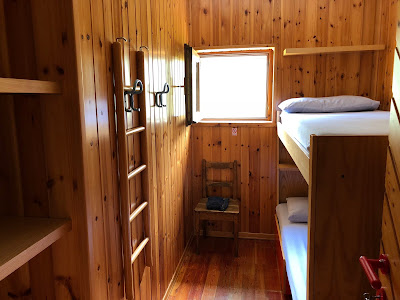
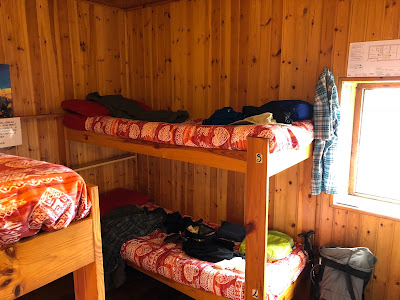


Examples of the sleeping the mountain lodges (rifugi). Left: Two-person room at Rifugio Calvi. Center Left: Four-person room at Rifugio Coca. Center Right: Four-person room (used for just two) at Ostello Curò. Right: Four-person room at Laghi Gemelli.
What were the bathroom and showers like?
Bathrooms were generally clean and spacious. There was no hot
water in the bathroom faucets, except at the Ostello at Curò. The showers though always had hot water. The water in the bathrooms is not potable; you fill up on water from a fountain outside the rifugio.
Toilets were 80% Turkish style and 20% normal style.
Toilets were 80% Turkish style and 20% normal style.
We typically
arrived at our destination rifugio early
afternoon, ate lunch, and then showered mid-afternoon. Therefore, we were
generally the first in, which was a good strategy. The cost for
showers was anywhere from 2 to 4 euros and for a few minutes of shower time. In a few
places, there wasn't an enforced time-limit. But in a rifugio brief showers are as much courtesy as necessity.
What were the prices like?
We paid about 80 euros per day for the two of us for ½ room
and board, which includes breakfast and dinner, and other 20 - 30 euros for lunch; about a 110 euros a day for two people. If you don’t have CAI membership card, expect
to pay a little more
We paid four of our six nights with credit card and two with cash. That said, it's always useful to have cash. For example, if connectivity is down there is no way to take credit card.
We paid four of our six nights with credit card and two with cash. That said, it's always useful to have cash. For example, if connectivity is down there is no way to take credit card.
What was the food like?
The food in general was good and plentiful. This being Italy
and in particular Bergamo, you can expect a few staples like polenta (served in
various modes), pasta (with tomato or meat sauce, sometimes pizzoccheri), a soup (e.g.,
barley or minestrone), a beef or pork meat dish. Desserts were usually homemade
crostata or cake.
The breakfasts were light, typically just dried toast in
packs, coffee, some butter and jam. We had been warned about this, so to supplement
this, we brought dried prunes, apricots, and dates.
We ate all our meals except one at rifugi. We met some people
camping and at the end of long day they would come in and get hot water to mix up
the food they carried. It didn’t look like much fun. We would recommend avoiding doing this.
The day we didn’t eat in a rifugio was lunch on our 6th day, which was a long
hike with no convenient lunch spot along the way. So, we ordered sandwiches the
night before and carried those with us. Most rifugi can prepare something for you food-wise if you let them know ahead of time.
Finally, rifugi have
many snacks for sale like chocolate, cookies, or chips. Buy them as you need
them and skip carrying them with you. Prices are reasonable.
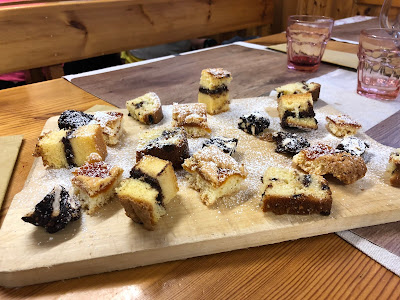

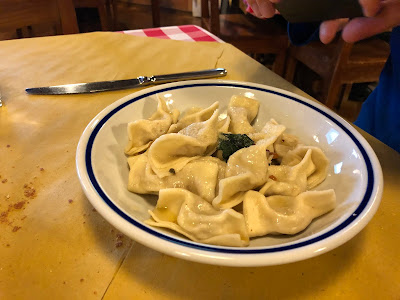




Examples of rifugio food we had during the hike. From left to right. 1. Desserts at Rifugio Brunone. 2. Stinco di maiale at Rifugio Albani. 3. Casoncelli at Rifugio Coca. 4. Speck, eggs and polenta at Rifugio Barone. 5. Lunch of minestrone and pasta at Rifugio Calvi. 6. Polenta, cheese and sausage at Rifugio Laghi Gemelli. 7. Pizzoccheri at Rifugio Barbellino.
What should I bring?
Our backpacks, fully weighted were about 12-13 kg or about
26 – 29 lbs. Fully loaded for us includes 2.5 liters of water, which weights 2.5
kg or 5.5 lbs. As we drank down our water each day, the pack got lighter.
Our backpacks where 45 + 10 liters and 50 + 10 liters. The plus part is what they can expand to
additionally.
Suggested items to take:
- Saco a pelo / saccolenzuolo (sleeping bag liner). You can rent this in most rifugi. We brought our own.
- Travel towel.
- Charger adapters for whatever devices you bring.
- Ear plugs if someone else’s snoring bothers you.
- Walking poles.
- Hiking pants that zip off to create shorts. We were glad for longer pants a couple of times during the hike, to keep sun off our legs, on wet days, and when going through meadows with tall plants and grasses heavy with dew.
- Rain gear. We used ponchos. A backpack rain cover.
- Hiking shoes, we would recommend boots with good ankle support.
- Cold weather gear such as roll-up light down jacket, hat, gloves. You’d be surprised that after a day of walking and then downtime how cold you can feel even if the temperature outside isn’t that cold.
- A small first aid kit.
- Sunscreen and sunglasses.
- Any special snacks you *really need* when hiking.
- A change of at least one shirt. We brought 3 hiking shirts and one evening dinner shirt. Each day, as soon as we reached a rifugio, we tried to change and hang clothes out to air out.
Optional items:
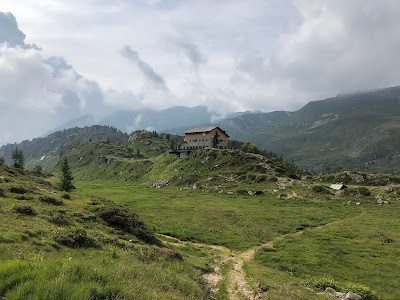


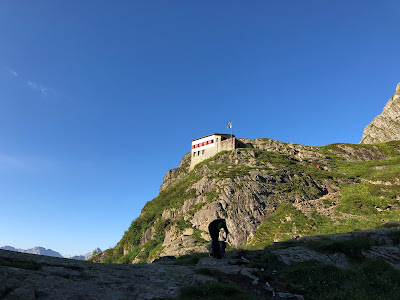


Some rifugi visited in this hike. From left to right: 1. Rifugio Calvi. 2. Approaching Rifugio Brunone - the most remote of rifugi on this tour. 3. Front of Rifugio Brunone. 4. Rifugio Coca. 5. Rifugio Curò Ostello. 6. Rifugio Barbellino - a non-CAI-owned rifugio at which we ate only lunch.

![[Hypericaceae] Hypericum maculatum – Imperforate or Spotted St John’s Wort (Erba di S. Giovanni macchiata) [Hypericaceae] Hypericum maculatum – Imperforate or Spotted St John’s Wort (Erba di S. Giovanni macchiata)](https://blogger.googleusercontent.com/img/b/R29vZ2xl/AVvXsEhLe-1NeKwNqPH5B8hzB2bO12aS6aR1uzkp76JNOlpYFeSIFHImvDNICdYZxixHp5kBpbzlXuYLEovGo1CX_uXYGWmqaH5KNV8Y8ui1Q2M45ox6wZ5aeXe6mAenBgDzUjzTdTOkgCEdLQ/s400/%255BHypericaceae%255D+Hypericum+maculatum.jpg)
![[Linaceae] Linum usitatissimum – Common Flax, Linseed (Lino selvatico) [Linaceae] Linum usitatissimum – Common Flax, Linseed (Lino selvatico)](https://blogger.googleusercontent.com/img/b/R29vZ2xl/AVvXsEiTdlaf5cQLH23cxgIM9a8nYgUoKEiXQxwksKBUalel5lqyoleQ4_mG-s4l3BorWjsjh49_mfbJSlLR4y5loHmZ74WoqfTXgeNPpx4OPXuGsIJ7mBiHgSHU7new09wboZtPCGSYsKFpsDs/s400/%255BLinaceae%255D+Linum+usitatissimum+%25E2%2580%2593+Common+Flax%252C+Linseed+%2528Lino+selvatico%2529.jpg)
[Linaceae] Linum usitatissimum – Common Flax, Linseed (Lino selvatico)
![[Melanthiaceae] Veratrum album – White Hellebore (Veratro bianco) [Melanthiaceae] Veratrum album – White Hellebore (Veratro bianco)](https://blogger.googleusercontent.com/img/b/R29vZ2xl/AVvXsEgE2Gt8qI9StPk9yLG6Nf0SW870FRQ7_eEf9uS90Vw1f_bRLbjwEB6mW4HbarYl28-CPPE5ET2-gnQFySupnsaVff7mu332YVdElTqRhPF1YU3OrlAD4AcJSCcjaz7kS5IxCtE2XLm5FWo/s400/%255BMelanthiaceae%255D+Veratrum+album.jpg)
[Melanthiaceae] Veratrum album – White Hellebore (Veratro bianco)
![[Orchidaceae] Epipactis helleborine – Helleborine (Elleborina comune) [Orchidaceae] Epipactis helleborine – Helleborine (Elleborina comune)](https://blogger.googleusercontent.com/img/b/R29vZ2xl/AVvXsEhyd7qQybqOi5wtFpX8iWc_3WFFhNru3KMMZfXDJtGXEkhC-NVof9tpmS44sFUd-mmIx1xx4v3jsTfJBTvl1YKzsUyxdBqoPfzZq2ldHjOFMS9n5_C8e-C47-AP_mFbGiNsUc5Yy3qKNQ/s400/%255BOrchidaceae%255D+Epipactis+helleborine+%25281%2529.jpg)
![[Orchidaceae] Epipactis helleborine – Helleborine (Elleborina comune) [Orchidaceae] Epipactis helleborine – Helleborine (Elleborina comune)](https://blogger.googleusercontent.com/img/b/R29vZ2xl/AVvXsEiRpMj4wF8YleFh-CP-i3FLkhoUuabDLRdVtlDBc22sLTsykSNSsOX82X-P8HXcrOgkWIxyYeSkI3OWH_D9J-INf67c84fGlM6GJaka3S90v7eXkrNsc5D-4mEaJXfjPMOkC_c4q1lbPQ/s400/%255BOrchidaceae%255D+Epipactis+helleborine+%25282%2529.jpg)
- Bug repellent. There were a few times when flies were a bit annoying but nothing serious. We didn’t experience mosquitoes. We didn’t use any repellent and were fine.
- Climbing gloves. This hike (the “classic” route) is such that most of the time you are going around upper Val Seriana, clockwise. Think of this as a huge cup and traversing the rim clockwise. Most of the time our left hand was grabbing tuffs of grass, rock, chains, or any other hand hold. We got scratched up a bit on the left hand and I thought maybe a glove for protecting the hand could be helpful.
- Second pair of light shoes to wear around the rifugio. Most people just bring boots and wear the slippers provided by the rifugio. Bringing a lighter pair of shoes – space permitting – allows you to take advantage of any smaller trails around the rifugio, i.e., you can get out and explore a little while giving your boots a rest.
- Hat. We never leave home without our trusty Tilley hats. Great for keeping the sun and light rain off your head.
- Platypus water bladder or similar water management system. The way the trails are, it’s nice to be able to sip water without having to take off your backpack or grapple to find your water bottle. And, in many cases on this trail, it’s dangerous to do so. All the rifugi had outdoor fountains to fill up on water. In fact, we never saw a place inside a rifugio where the water was potable (exception being the Ostello at Curò). We never bought water.
(top)
Glossary
If you are thinking about doing this hike, here’s a short
glossary of terms that will be helpful to you.
Alpi Orobie –
Sometimes just called the Orobie in Italian. In English, they are
referred to with wordy Bergamasque Alps.
The Orobie are a mountain range in the Italian Alps, in northern
Lombardy just north of Bergamo. This is the location of the hike. The word
orobie – according to Treccani – comes
from Latin Orobbi designating a pre-Roman population from Liguria or Gallica
that settled in these mountains.
Bergamo Alps – Another way to say Bergamasque Alps or Alpi
Orobie.
CAI Bergamo – CAI stands for Club Alpino Italiano.
They do many things including marking and maintaining trails as well as
operating rifugi. There are many different subsections of CAI in Italy and
Bergamo is one such club. Bergamo is special because it is particularly
well-organized (from what we can tell) and their web site resources are
indispensable for planning.
EE – Escursionisti esperti or “experienced
hikers”. Most of the trails described in this post are marked EE. From easy to
hard, the scale is T (turistico / tourist), E (escursionistico
/ easy to medium hiking), EE, and EEA (escursionisti esperti con attrezzatura
/ experienced hikers with proper equipment). EE means dealing with hand holds,
chains, or navigating some narrow trails.
Insubria – A term that appears in many contexts and often in the
scientific names of plants, Insubria refers approximately to modern day Lombardy. Starting in the 4th century
BC, a population of Gauls – called Insubres – inhabited this area.
Mario Merelli (1962
– 2012) – a Italian alpinista and local hero who grew up in the Valle Seriana
(Lizzola). Walking the Sentiero delle
Orobie, you see his name mentioned a lot. Rifugio Coca was renamed in his
honor as Rifugio
Mario Merelli al Coca. Merelli died climbing Pizzo di Scais above Rifugio
Coca.
Rifugio – is a
mountain hut, but before you let the word “hut” conjure the wrong image you
need to know that rifugi (plural in Italian) serve
wonderful hot meals, offer half or full room and board, often have showers and
often private rooms. This hike spends one night in six different rifugi. A rifugista is someone who runs a rifugio.
(No they are not refugees.)






Some rifugi visited in this hike. From left to right: 1. Rifugio Calvi. 2. Approaching Rifugio Brunone - the most remote of rifugi on this tour. 3. Front of Rifugio Brunone. 4. Rifugio Coca. 5. Rifugio Curò Ostello. 6. Rifugio Barbellino - a non-CAI-owned rifugio at which we ate only lunch.
Saco a pelo / saccolenzuolo
– Is a sleeping bag liner. Rifugi
require you to have this. Rifugi provide everything else (pillow, covered
mattress, and blankets). The idea is that you put your body in the sleeping
back liner so you don’t touch what’s there. Liners can be rented.
Sentiero – Is
the Italian word for trail.
Sentiero delle Orobie centro-orientali – (Italian
overview, English
overview) This is the name of the trail we followed in the central-eastern
Orobie. There is a Sentiero delle
Orobie Occidentale, or western trail as well. The trail was conceived and
carried out between 1950 and 1975.
Valle Brembana – Valle or Val Brembana is one of the major
valleys that extends north of Bergamo. The Brembo river runs through this valley.
The initial part of this hike takes you to the eastern edge of this valley. San
Pellegrino water comes from this valley.
Valle Seriana – Valle or Val Seriana is another major valley
north of Bergamo and east of Valle Brembana. The Serio river runs through this
valley. Most of the hike takes places in the upper part of the valley around
Valbondione.
Via Ferrata – A climbing path used in the Alps – and in the Bergamasque
Alps – that consists of steel cables, rungs, and other climbing aids. There is a
variant of the Sentiero delle Orobie that goes from Rifugio Albani up over
Presolana (Sentiero
326) that is a via ferrata. We
did not take this route, instead we returned to Ardesio on a simpler route.
(top)
Flora
Our list below captures about 80% of what we saw on this hike and were able to reasonably identify. We used the resources listed in the post Resources
for Identifying Plants around Bergamo to identify plants shown here and probably about 95% accurate for species and 98% accurate for genus. For a
list of flowers we’ve identified in the Bergamasque Prealps, see our Pinterest
page Bergamasque Prealps Flowers and Plants.
There is also a companion post Seven Days on the Sentiero delle Orobie - Up Close with Flowers of the Bergamo Alps that features photos of many of these plants.
There is also a companion post Seven Days on the Sentiero delle Orobie - Up Close with Flowers of the Bergamo Alps that features photos of many of these plants.
Key: [Family] Genus species – Common name in English (Common name in Italian)
[Amaryllidaceae] Allium
victoralis – Alpine Leek (Aglio
serpentino)
[Apiaceae] Bupleurum
petraeum – Rock Hare’s Ear (Bupleuro
delle rocce)
![[Apiaceae] Astrantia major – Greater Masterwort (Astranzia maggiore) [Apiaceae] Astrantia major – Greater Masterwort (Astranzia maggiore)](https://blogger.googleusercontent.com/img/b/R29vZ2xl/AVvXsEhiuCmHlAVnheN7Y6rOSbYMWU0VK3jmJMpCYciZ5V8COVOCI2vGZQuMPDOdwm7k3w9C40ksxazVh1CLRMHM5q2gL09jY35h_zDc2XqDRlj_i17Kgq17NoiUCsrxz-HHPHkPGF_lbDfpaes/s400/%255BApiaceae%255D+Astrantia+major+-+Great+Masterword+%2528Astranzia+maggiore%2529.jpg)
[Apiaceae] Astrantia minor – Minor Masterwort (Astranzia minore)
![[Apiaceae] Astrantia major – Greater Masterwort (Astranzia maggiore) [Apiaceae] Astrantia major – Greater Masterwort (Astranzia maggiore)](https://blogger.googleusercontent.com/img/b/R29vZ2xl/AVvXsEhiuCmHlAVnheN7Y6rOSbYMWU0VK3jmJMpCYciZ5V8COVOCI2vGZQuMPDOdwm7k3w9C40ksxazVh1CLRMHM5q2gL09jY35h_zDc2XqDRlj_i17Kgq17NoiUCsrxz-HHPHkPGF_lbDfpaes/s400/%255BApiaceae%255D+Astrantia+major+-+Great+Masterword+%2528Astranzia+maggiore%2529.jpg)
[Apiaceae] Astrantia minor – Minor Masterwort (Astranzia minore)
[Asteraceae] Adenostyles
alliariae - (Cavolaccio alpino)
- We are going with A. alliariae over A. alpina based on little “ear-like” leaves at the base of petioles of A. alliariae.
[Asteraceae] Arctium
spp. – Burdock (Bardana)
- Likely A. minor, but we didn’t stop to look carefully at the plant.
[Asteraceae] Prenanthes purpurea – Purple Lettuce (Lattuga montana porporina)
[Asteraceae] Jacobaea carniolica
– Grey Alpine Groundsel (Senecione
biancheggiante della Carniola)
- A synonym according to Flora Italiana is Jacobaea incana subsp. carniolica. Biancheggiare is the verb to become white. Carniola refers to a historical region that is Slovenia today. We found around Ol Simal.
[Asteraceae] Lactuga
alpina – Blue Sow Thistle (Lattuga
alpina)
- A relative of the garden lettuce Lactuga sativa.
[Asteraceae] Leontopodium
nivale subsp. alpinum – Edelweiss
(Stella alpina)
- We were complaining that we hadn’t seen any of these and then suddenly they appeared. We found this just before and after Pizzo di Petto.
[Asteraceae] Leucanthemopsis
alpina – Alpine Moon Daisy (Margherita
alpina)
![[Brassicaceae] Noccaea rotundifolium – Round Leaved Penny Cress (Erba storna a foglie rotunda) [Brassicaceae] Noccaea rotundifolium – Round Leaved Penny Cress (Erba storna a foglie rotunda)](https://blogger.googleusercontent.com/img/b/R29vZ2xl/AVvXsEgwWFtvwenEcfSdgvySSRAu5h8lWPFSZmoBVfgP8eldPECnPDq87Gx7wwMw0mF6D9VlThl_rQYFhyDt05Spd7UXHGq5I7V0Mkt4-4hIzR4wG1GW-wdz661Q3Jw1Yn3TuEBu1OyxTdYLlL4/s400/%255BBrassicaea%255D+Noccaea+rotundifolium.jpg)
[Brassicaceae] Noccaea rotundifolium – Round Leaved Penny Cress (Erba storna a foglie rotunda)
![[Brassicaceae] Noccaea rotundifolium – Round Leaved Penny Cress (Erba storna a foglie rotunda) [Brassicaceae] Noccaea rotundifolium – Round Leaved Penny Cress (Erba storna a foglie rotunda)](https://blogger.googleusercontent.com/img/b/R29vZ2xl/AVvXsEgwWFtvwenEcfSdgvySSRAu5h8lWPFSZmoBVfgP8eldPECnPDq87Gx7wwMw0mF6D9VlThl_rQYFhyDt05Spd7UXHGq5I7V0Mkt4-4hIzR4wG1GW-wdz661Q3Jw1Yn3TuEBu1OyxTdYLlL4/s400/%255BBrassicaea%255D+Noccaea+rotundifolium.jpg)
[Brassicaceae] Noccaea rotundifolium – Round Leaved Penny Cress (Erba storna a foglie rotunda)
[Boraginaceae] Eritrichum
nanum – Arctic Alpine Forget-me-Not (Eritrichio
nano)
[Campanulaceae] Phyteuma
ovatum – Dark Rampion (Raponzolo
plumbeo)
- Tall, dark and handsome.
[Caryophyllaceae] Saponaria
officinalis – Bouncingbet, Common Soapwort (Saponaria comune)
- A lower altitude, roadside plant.
[Caryophyllaceae] Silene
flos-cuculi subsp. flos-cuculi –
Ragged Robin (Crontonella for di cuculo)
![[Caryophyllaceae] Silene vulgaris – Bladder Campion (Silene comune) [Caryophyllaceae] Silene vulgaris – Bladder Campion (Silene comune)](https://blogger.googleusercontent.com/img/b/R29vZ2xl/AVvXsEgGW-sN0d2cMBI81arLgrxWwYOLZcdqmagBFmGTMg0ZMspoaHAmfCzje8J1FlK7TwKjWIo0C2ZAuldMEKiAgBZZT_aG2egfwsYtWr1kDLOCS8eQgwa9EjvhaLxHfowqXrnI9UsGnfGUJl4/s400/%255BCaryophyllaceae%255D+Silene+vulgaris.jpg)
[Caryophyllaceae] Silene vulgaris – Bladder Campion (Silene comune)
![[Caryophyllaceae] Silene vulgaris – Bladder Campion (Silene comune) [Caryophyllaceae] Silene vulgaris – Bladder Campion (Silene comune)](https://blogger.googleusercontent.com/img/b/R29vZ2xl/AVvXsEgGW-sN0d2cMBI81arLgrxWwYOLZcdqmagBFmGTMg0ZMspoaHAmfCzje8J1FlK7TwKjWIo0C2ZAuldMEKiAgBZZT_aG2egfwsYtWr1kDLOCS8eQgwa9EjvhaLxHfowqXrnI9UsGnfGUJl4/s400/%255BCaryophyllaceae%255D+Silene+vulgaris.jpg)
[Caryophyllaceae] Silene vulgaris – Bladder Campion (Silene comune)
[Crassulaceae] Rhodiola
rosea – Roseroot Stonecrop (Rodiola
rosea)
[Crassulaceae] Sedum
dasyphyllum – Thick Leaved Stonecrop (Borracina
cenerina)
[Cyperaceae] Eriophorum
scheuchzeri – White Cotton Grass (Pennacchi
di Scheuchzer)
- Or, these could be E. vaginatum. When you see either of these plants it means boggy ground.
[Ericaceae] Vaccinium
myrtillus – Blue Whortleberry, European Blueberry (Mirtillo nero)
[Fabiaceae] Trifolium
badium – Brown Clover (Trifoglio
bruno)
- This pea-family plant caught our eye because alongside little yellow flowers are brown, spent flowers that are hard to miss due to the contrast between new and old.

[Gentianaceae] Gentiana
clusii – Trumpet Gentian (Genziana di
Clusius)
- Based on absence of green inside flower, we are saying G. clusii rather than G. acaulis.
[Gentianaceae] Gentiana
pannonica – Hungarian Gentian (Genziana
rossigna)
- According to RedList it’s rare in Italy, while Acta Plantarum indicates it is found in Lombardy (mountains). The species epithet refers to historical region of Pannonia, which comprises part of present-day western Hungary.
[Gentianaceae] Gentiana
punctata – Spotted Gentian (Genziana
punteggiata)
[Gentianaceae] Gentiana
purpuea – Purple Gentian (Genziana
porporina)
[Gentianaceae] Gentiana
utriculosa – Bladder Gentian (Genziana
alata)
![[Hypericaceae] Hypericum maculatum – Imperforate or Spotted St John’s Wort (Erba di S. Giovanni macchiata) [Hypericaceae] Hypericum maculatum – Imperforate or Spotted St John’s Wort (Erba di S. Giovanni macchiata)](https://blogger.googleusercontent.com/img/b/R29vZ2xl/AVvXsEhLe-1NeKwNqPH5B8hzB2bO12aS6aR1uzkp76JNOlpYFeSIFHImvDNICdYZxixHp5kBpbzlXuYLEovGo1CX_uXYGWmqaH5KNV8Y8ui1Q2M45ox6wZ5aeXe6mAenBgDzUjzTdTOkgCEdLQ/s400/%255BHypericaceae%255D+Hypericum+maculatum.jpg)
[Hypericaceae] Hypericum
maculatum – Imperforate or Spotted St John’s Wort (Erba di S. Giovanni macchiata)
[Lamiaceae] Betonica
hirsuta – Common Hedgenettle, Purple Betony (Betonica del monte Prada)
[Lentibulariaceae] Pinguicula
vulgaris – Common Butterwort (Erba
unta comune)
- This butterwort is a perennial carnivorous plant. Take a close look at the photo above the the small insects caught on the sticky leaves.
[Liliaceae] Lilium
martagon - Martagon Lily, Turk’s Cap Lily (Giglio a turbante, Giglio martagone).
- We saw the Martagon Lily on most days of the walk.
![[Linaceae] Linum usitatissimum – Common Flax, Linseed (Lino selvatico) [Linaceae] Linum usitatissimum – Common Flax, Linseed (Lino selvatico)](https://blogger.googleusercontent.com/img/b/R29vZ2xl/AVvXsEiTdlaf5cQLH23cxgIM9a8nYgUoKEiXQxwksKBUalel5lqyoleQ4_mG-s4l3BorWjsjh49_mfbJSlLR4y5loHmZ74WoqfTXgeNPpx4OPXuGsIJ7mBiHgSHU7new09wboZtPCGSYsKFpsDs/s400/%255BLinaceae%255D+Linum+usitatissimum+%25E2%2580%2593+Common+Flax%252C+Linseed+%2528Lino+selvatico%2529.jpg)
[Linaceae] Linum usitatissimum – Common Flax, Linseed (Lino selvatico)
![[Melanthiaceae] Veratrum album – White Hellebore (Veratro bianco) [Melanthiaceae] Veratrum album – White Hellebore (Veratro bianco)](https://blogger.googleusercontent.com/img/b/R29vZ2xl/AVvXsEgE2Gt8qI9StPk9yLG6Nf0SW870FRQ7_eEf9uS90Vw1f_bRLbjwEB6mW4HbarYl28-CPPE5ET2-gnQFySupnsaVff7mu332YVdElTqRhPF1YU3OrlAD4AcJSCcjaz7kS5IxCtE2XLm5FWo/s400/%255BMelanthiaceae%255D+Veratrum+album.jpg)
[Melanthiaceae] Veratrum album – White Hellebore (Veratro bianco)
- In the USA, V. album is something that doesn't look like this plant at all. This is definitely a Veratrum, but there is some discrepancy between the name given on the Flora Italiana site with the one used in the States.
[Onagraceae] Chamaenerion
angustifolium – Rosebay Willow Herb (Garafonino
maggiore)
![[Orchidaceae] Epipactis helleborine – Helleborine (Elleborina comune) [Orchidaceae] Epipactis helleborine – Helleborine (Elleborina comune)](https://blogger.googleusercontent.com/img/b/R29vZ2xl/AVvXsEhyd7qQybqOi5wtFpX8iWc_3WFFhNru3KMMZfXDJtGXEkhC-NVof9tpmS44sFUd-mmIx1xx4v3jsTfJBTvl1YKzsUyxdBqoPfzZq2ldHjOFMS9n5_C8e-C47-AP_mFbGiNsUc5Yy3qKNQ/s400/%255BOrchidaceae%255D+Epipactis+helleborine+%25281%2529.jpg)
![[Orchidaceae] Epipactis helleborine – Helleborine (Elleborina comune) [Orchidaceae] Epipactis helleborine – Helleborine (Elleborina comune)](https://blogger.googleusercontent.com/img/b/R29vZ2xl/AVvXsEiRpMj4wF8YleFh-CP-i3FLkhoUuabDLRdVtlDBc22sLTsykSNSsOX82X-P8HXcrOgkWIxyYeSkI3OWH_D9J-INf67c84fGlM6GJaka3S90v7eXkrNsc5D-4mEaJXfjPMOkC_c4q1lbPQ/s400/%255BOrchidaceae%255D+Epipactis+helleborine+%25282%2529.jpg)
[Orchidaceae] Epipactis
helleborine – Helleborine (Elleborina
comune)
[Orchidaceae] Gymnadenia odoratissima– Sweetest Orchid (Manina
profumata)
- There is a small probability we are looking at O. conopsea. We saw this specimen at around 2000 m, which is a bit high for O. odoratissima.
[Orchidaceae] Platanthera
bifolia – Lesser Butterfly-Orchid (Platantera
comune)
- Seen near Rifugio Calvi, below 2000 m.
[Orchidaceae] Pseudorchis
albida – Small White Orchid (Orchide
albida)
[Orobanchaceae] Pedicularis
kerneri – (Pedicolare di Kerner)
- About 95% sure of species epithet.
[Papaveraceae] Pseudofumaria
lutea – Yellow Corydalis (Colombina
gialla)
[Papaveraceae] Papaver
alpinum – Rhaetian Poppy (Papavero
alpino)
[Plantaginaceae] Globularia
cordifolia – Matted Globularia, Heart-Leaved Globe Daisy (Vedovella a foglie cordate)
[Primulaceae] Primula
daonensis – (Primula della Valle di
Daone)
[Pteridaceae] Cryptogramma crispa – Parsley Fern (Felcetta crespa)
- We usually don’t mention ferns (felce/i), but this one always catches my eye sticking out from under rocks and resembling parsley.
[Plantaginaceae] Linaria
alpina – Alpine Toadflax (Linajola
alpina)
[Ranunculaceae] Aconitum
lycoctonum – Wolfsbane (Aconito lupaia)
![[Ranunculaceae] Pulsatilla alpina – Alpine Pasqueflower (Plusatilla alpina) [Ranunculaceae] Pulsatilla alpina – Alpine Pasqueflower (Plusatilla alpina)](https://blogger.googleusercontent.com/img/b/R29vZ2xl/AVvXsEhWTbmCU_oc15i5Lsxzsh9AooTthrS_GbNGYOFA56VBwqib5axcF5j1wFBhYkUhN6PPCp6fz8_axgXA65BnXvaEQbBS7RjCy1dkLFc1ZfRcOVjM4ZlOmjug8SRz1zGqsvCzKh0lnnMkefg/s1600/%255BRanunculaceae%255D+Pulsatilla+alpina.jpg)
![[Ranunculaceae] Pulsatilla alpina – Alpine Pasqueflower (Plusatilla alpina) [Ranunculaceae] Pulsatilla alpina – Alpine Pasqueflower (Plusatilla alpina)](https://blogger.googleusercontent.com/img/b/R29vZ2xl/AVvXsEg0vtNdFYe7Xc8YjtbawpnInQRUgOoZcPREp3cI1qlUyeF8byiYmVOKaNn4WldXj1OEnn44B8vi92n0HRe1t7qlT7TwkJr7x_6tDcAb02tsA1kMh5Pj14ksHXhaeW4wOAsvZ6x0Lvj3h-o/s1600/%255BRanuculaceae%255D+Pulsatilla+alpina.jpg)
[Ranunculaceae] Pulsatilla alpina – Alpine Pasqueflower (Plusatilla alpina)
![[Ranunculaceae] Pulsatilla alpina – Alpine Pasqueflower (Plusatilla alpina) [Ranunculaceae] Pulsatilla alpina – Alpine Pasqueflower (Plusatilla alpina)](https://blogger.googleusercontent.com/img/b/R29vZ2xl/AVvXsEhWTbmCU_oc15i5Lsxzsh9AooTthrS_GbNGYOFA56VBwqib5axcF5j1wFBhYkUhN6PPCp6fz8_axgXA65BnXvaEQbBS7RjCy1dkLFc1ZfRcOVjM4ZlOmjug8SRz1zGqsvCzKh0lnnMkefg/s1600/%255BRanunculaceae%255D+Pulsatilla+alpina.jpg)
![[Ranunculaceae] Pulsatilla alpina – Alpine Pasqueflower (Plusatilla alpina) [Ranunculaceae] Pulsatilla alpina – Alpine Pasqueflower (Plusatilla alpina)](https://blogger.googleusercontent.com/img/b/R29vZ2xl/AVvXsEg0vtNdFYe7Xc8YjtbawpnInQRUgOoZcPREp3cI1qlUyeF8byiYmVOKaNn4WldXj1OEnn44B8vi92n0HRe1t7qlT7TwkJr7x_6tDcAb02tsA1kMh5Pj14ksHXhaeW4wOAsvZ6x0Lvj3h-o/s1600/%255BRanuculaceae%255D+Pulsatilla+alpina.jpg)
[Ranunculaceae] Pulsatilla alpina – Alpine Pasqueflower (Plusatilla alpina)
[Ranunculaceae] Ranunculus
glacialis – Glacier Buttercup (Ranunculo
delle nevi)
[Ranunculaceae] Ranunculus
aconitifolius – Aconite-Leaf Buttercup (Ranuncolo
a foglie di aconito)
[Ranunculaceae] Thalictrum
aquilegifolium – Columbine Mead-Rue (Pigamo
colombino)
[Rosaceae] Dryas
octopetala – White Dryas (Camedrio
alpino)
[Rosaceae] Geum
reptans – Creeping Avens (Cariofillata
strisciante)
- Seen only in the highest parts of the trail, above 2000 m, in particular near Ol Simal, day 4
[Rosaceae] Geum rivale
– Purple or Water Avens (Cariofillata dei
ruscelli)
- Most we saw were past their prime, but their unmistakable fuzzy flower seed heads make them easy to recognize.
[Rosaceae] Potentilla
nitida – Pink cinquefoil (Cinquefoglia
delle Dolomiti)
[Rosaceae] Rosa
spp.
[Rosaceae] Rubus
idaeus – American Red Raspberry (Lampone)
[Rosaceae] Sanguisorba
dodecandra – Italian Burnet (Salvastrella
con dodici stami)
- Endemic to the alpine region of Italy, where it is only found in the Orobic and Raethian Alps (Lombardy Region, province of Sondrio and province of Bergamo).
[Rubiaceae] Galium
spp. – Bedstraw (Caglio)
[Saxifragaceae] Micranthes
engleri – Starry Saxifrage (Sassifraga
di Engler, Sassifraga stellata)
[Saxifragaceae] Saxifraga
bryoides – Mossy Saxifrage (Sassifraga
brioide)
![[Saxifragaceae] Saxifraga hostii – Host's Saxifrage (Sassifraga di Host) [Saxifragaceae] Saxifraga hostii – Host's Saxifrage (Sassifraga di Host)](https://blogger.googleusercontent.com/img/b/R29vZ2xl/AVvXsEjo4rlNvKuUKF-Fe8D8JQbhR49DHq_q3i18x9Hc4oZx3eRvrmI5-YN-pNxp66OZD0K6x30WvOv-PPgFZ4hb4WoOyZP4Rh6T0M11uUFMupseVaB1uGWW79bomsP4Yw4xHNlJB75p5OOooLE/s400/%255BSaxifragaceae%255D+Saxifraga+hostii%25E2%2580%2593+Host%2527s+Saxifrage+%2528Sassifraga+di+Host%2529.jpg)
[Saxifragaceae] Saxifraga hostii – Host's Saxifrage (Sassifraga di Host)
![[Saxifragaceae] Saxifraga hostii – Host's Saxifrage (Sassifraga di Host) [Saxifragaceae] Saxifraga hostii – Host's Saxifrage (Sassifraga di Host)](https://blogger.googleusercontent.com/img/b/R29vZ2xl/AVvXsEjo4rlNvKuUKF-Fe8D8JQbhR49DHq_q3i18x9Hc4oZx3eRvrmI5-YN-pNxp66OZD0K6x30WvOv-PPgFZ4hb4WoOyZP4Rh6T0M11uUFMupseVaB1uGWW79bomsP4Yw4xHNlJB75p5OOooLE/s400/%255BSaxifragaceae%255D+Saxifraga+hostii%25E2%2580%2593+Host%2527s+Saxifrage+%2528Sassifraga+di+Host%2529.jpg)
[Saxifragaceae] Saxifraga hostii – Host's Saxifrage (Sassifraga di Host)
[Urticaceae] Urtica
dioica – Stinging Nettle (Ortica
comune)
- Including this plant to alert readers that they shouldn’t really touch this plant or let it brush up against you when it’s in bloom, or else, as the name indicates, it will sting.
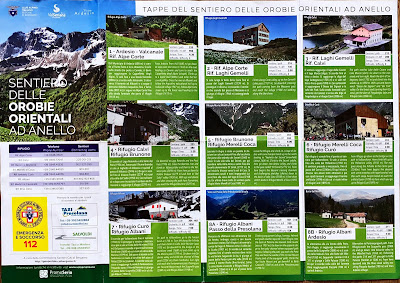

![[Amaryllidaceae] Allium victoralis – Alpine Leek (Aglio serpentino) [Amaryllidaceae] Allium victoralis – Alpine Leek (Aglio serpentino)](https://blogger.googleusercontent.com/img/b/R29vZ2xl/AVvXsEiGYZJp3ZNoPlOSSS28GZ9i-3x3fOqVEphYGQ5pHBtYNDTbTLYk6KLdGghfjkDSKt4wbLSW_Yg6sPKqhAwaTxQqXdvxoQRzvICm31NH_Qj_vE4J2sxt4gsAlmraGyY2ZU1MvGwMp-2KJLY/s400/%255BAmaryllidaceae%255D+Allium+victoralis+%25E2%2580%2593+Alpine+Leek+%2528Aglio+serpentino%2529.jpg)
![[Amaryllidaceae] Allium victoralis – Alpine Leek (Aglio serpentino) [Amaryllidaceae] Allium victoralis – Alpine Leek (Aglio serpentino)](https://blogger.googleusercontent.com/img/b/R29vZ2xl/AVvXsEh9b5x6o1Xo8o1wva-is5gR3LoyGx7dsDEoVpZflJYDS0G3TAXgxvznR5sWXX4t79fUTIXUfGQb3jGXJ3giaaHWMFT3brPhn96Woz9PMosCUeyS6-aiNkGaOh14H-baEnqwjx3saXebuA/s400/%255BAmaryllidaceae%255D+Allium+victoralis.jpg)
![[Amaryllidaceae] Allium schoenoprasum– Wild Chives (Erba cipollina) [Amaryllidaceae] Allium schoenoprasum– Wild Chives (Erba cipollina)](https://blogger.googleusercontent.com/img/b/R29vZ2xl/AVvXsEgoJEz1mcOY6xX5HoUxflfNxp1BP6Y3sajhalvsacXfmOCGTCSgOQRGS-xEyd_ym75sU-tsey7T6qi3qKhAMHyBO-j6vBL0AzVwa0yoQK6h_uti0zb-3XmOszVvKUZvHV5snYy5SMXCSvo/s400/%255BAmaryllidaceae%255D+Allium+schoenoprasum.jpg)

![[Apiaceae] Bupleurum petraeum – Rock Hare’s Ear (Bupleuro delle rocce) [Apiaceae] Bupleurum petraeum – Rock Hare’s Ear (Bupleuro delle rocce)](https://blogger.googleusercontent.com/img/b/R29vZ2xl/AVvXsEhI4HSD_LOPQfUh-T7lFtaF3gHyoKFaa90wjD_aJc5ZUA0vJSkzQXFczyMSu1LM9_iOKGuhem80mbiV80BcyAL-zH3IUdqQK2x4c6hWvg9iu-baMJgDS_uqMhEJAkyKJh6KQ67lxKNO8w/s400/%255BApiaceae%255D+Bupleurum+petraeum.jpg)
![[Apiaceae] Astrantia minor – Minor Masterwort (Astranzia minore) [Apiaceae] Astrantia minor – Minor Masterwort (Astranzia minore)](https://blogger.googleusercontent.com/img/b/R29vZ2xl/AVvXsEjRd_NOPjqx8dd6eNM3arkbnNgQ6B2KA1WQi2IbRn_QHCOSH4Nvwj8px2gFRcBdnyP9muv4Zb5dtoGjy7YQNLbLXMk_W2xkFfLbzK-mO4hF_qMsNWXbnt-0hYCB5Mrgk4C-KvqI7q3DP2E/s400/%255BApiaceae%255D+Astrantia+minor+%25E2%2580%2593+Minor+Masterwort+%2528Astranzia+minore%2529.jpg)
![[Asteraceae] Adenostyles alliariae - (Cavolaccio alpino) [Asteraceae] Adenostyles alliariae - (Cavolaccio alpino)](https://blogger.googleusercontent.com/img/b/R29vZ2xl/AVvXsEgvTaYD3cbbNwlngYBv7YMWji8d4piHClPh5gW2kI51MUJvyXz2TMdYI4zIVkzrwmlnWHTjFYJLN7suLlmY2hQMnyJnfXSFc250sl_qrw4euUEys9EW2vG0iv0kYRSL6dvOPhf5jtxf0A/s400/%255BAsteraceae%255D+Adenostyles+alliariae.jpg)
![[Asteraceae] Arctium spp. – Burdock (Bardana) [Asteraceae] Arctium spp. – Burdock (Bardana)](https://blogger.googleusercontent.com/img/b/R29vZ2xl/AVvXsEg_fTEeOLkKSxBcy4KA2zVRifd39-gMbobzAVkOjrv_uoJvLucmtkgVCICfmQELQ4zBK7UXYzXaQECn8M5eEcdllOBLVF1VXXY2nNznJq1UT_OLEMZhxhiuqxQgercnrzk_U2D2BWEkCww/s400/%255BAsteraceae%255D+Arctium+spp.jpg)
![[Asteraceae] Prenanthes purpurea – Purple Lettuce (Lattuga montana porporina) [Asteraceae] Prenanthes purpurea – Purple Lettuce (Lattuga montana porporina)](https://blogger.googleusercontent.com/img/b/R29vZ2xl/AVvXsEi9mJudmsAJgaymbnXNvaCao-4Tsta-KfzaKo65C8PI9BMa_5xMRMjmmmjCvwpHG0BTWPENQO3QA4ndtUIMAcM476iPcy5jWpPlMNplBMzr04qGP0SBskXHjHra0wZc6TcLaB6gzj1ytaQ/s400/%255BAsteracease%255D+Prenanthes+purpurea.jpg)
![[Asteraceae] Crespis aurea – Golden Hawk's Beard (Radicchiella aranciata) [Asteraceae] Crespis aurea – Golden Hawk's Beard (Radicchiella aranciata)](https://blogger.googleusercontent.com/img/b/R29vZ2xl/AVvXsEi40rZWqrW6z-SZ0h4uprfVxg6wTShJWqattY0XuYJAC4oF3-MlDKr_rtZnN9DL8zvaQnlQq-aU7bNsbKlP-K59U2Ku-ous11uZV05yT0rvADe2IMvgBvt_mnYeUNRe3fTfQhD8g7nRfXE/s400/%255BAsteraceae%255D+Crepis+aurea.jpg)
![[Asteraceae] Jacobaea carniolica – Grey Alpine Groundsel (Senecione biancheggiante della Carniola) [Asteraceae] Jacobaea carniolica – Grey Alpine Groundsel (Senecione biancheggiante della Carniola)](https://blogger.googleusercontent.com/img/b/R29vZ2xl/AVvXsEhM8AziTPBD2psqNF5I3_7FEtX4LCij0ij0NsAnO8gSD8CdQLMjAr3BLYf56qaP2P0UDN7LWK927s1swrZLzQCnjB5suO_T4hFho4b2rDzfHzcFqX0BxGmhjFrPohiEZuamwpbVphFSKA/s400/%255BAsteraceae%255D+Jacobaea+incana.jpg)
![[Asteraceae] Lactuga alpina – Blue Sow Thistle (Lattuga alpina) [Asteraceae] Lactuga alpina – Blue Sow Thistle (Lattuga alpina)](https://blogger.googleusercontent.com/img/b/R29vZ2xl/AVvXsEix2HvxEGBGy62sQzQt2ZQES2DyVfIHXyPOxfHP5gLosCtEfSc57vNzwwSqAR2biSGsXPF4oyk5thw6NkEMy8STwJqv1pkioUicM2DCRqHI4w8j_IzmLnGtHsT12SZqbVvE2q975VOvYg/s400/%255BAsteraceae%255D+Lactuga+alpina.jpg)
![[Asteraceae] Leontopodium nivale subsp. alpinum – Edelweiss (Stella alpina) [Asteraceae] Leontopodium nivale subsp. alpinum – Edelweiss (Stella alpina)](https://blogger.googleusercontent.com/img/b/R29vZ2xl/AVvXsEhMH-cpV8biO-drg0XFK1M74fNoFm8QXHLpD4WAOo6ZHw707pJygRCklvZiHFoZV3ykzYgIdKuGFhm-Nr2BjZ7eNh6AoLs0fegRJl6kSiLmrln08Kz2_naIq51RHn1mqMjrXVBTHSV-Dg/s400/%255BAsteraceae%255D+Leontopodium+nivale.jpg)
![[Asteraceae] Leontopodium nivale subsp. alpinum – Edelweiss (Stella alpina) [Asteraceae] Leontopodium nivale subsp. alpinum – Edelweiss (Stella alpina)](https://blogger.googleusercontent.com/img/b/R29vZ2xl/AVvXsEhW72OVJVmCLVZHdssmfqwu44Hky55s_SQ7sLVLCd9GxPeQSZnCkzyjTt2FipGKj69rTVx2n-QVEz0nYV8rI2I2NUYQzpuHkhKNVOXGJdRSO2b8EhLw1ZQm6Q6yE04YU9bV0Z0R910Do9Q/s400/%255BAsteraceae%255D+Leontopodium+nivale+subsp.+alpinum+%25E2%2580%2593+Edelweiss+%2528Stella+alpina%2529.jpg)
![[Asteraceae] Leucanthemopsis alpina – Alpine Moon Daisy (Margherita alpina) [Asteraceae] Leucanthemopsis alpina – Alpine Moon Daisy (Margherita alpina)](https://blogger.googleusercontent.com/img/b/R29vZ2xl/AVvXsEidvgx45WO2WdO-a_LiOMl6KHZyg870it07Kj2UX3kwQAiwnjPMw4KGXSixQpCcNsVb3-9er1q5xpqHIFKjQrA10Ze_iAMU5z2C34tSwrJkX1-QU77pEoJM2IjDsDWQjiJgCLvU0II4kQ/s400/%255BAsteraceae%255D+Leucanthemopsis+alpina.jpg)
![[Boraginaceae] Eritrichum nanum – Arctic Alpine Forget-me-Not (Eritrichio nano) [Boraginaceae] Eritrichum nanum – Arctic Alpine Forget-me-Not (Eritrichio nano)](https://blogger.googleusercontent.com/img/b/R29vZ2xl/AVvXsEj5wW3Sx14YeUCmGIaB1Sp7nVc8Hmoyi5Ogfte2qAm7OAlTi2SETahAe4u-2UwzCjaOmB7h2ru5ij8oV2sElQu-Uf9HFbaWmfkhIXRUrpk_R6sWMPmwLqw59VlVZ70UaD6xWgj4rCpdVA/s400/%255BBoraginaceae%255D+Eritrichum+nanum.jpg)
![[Campanulaceae] Phyteuma spp. – Rampion (Raponzolo) [Campanulaceae] Phyteuma spp. – Rampion (Raponzolo)](https://blogger.googleusercontent.com/img/b/R29vZ2xl/AVvXsEia_UyDq6e3vxww2Jx6UYol3BaLbIgM-etOq1uRmuv_nbDX0lbk_mg5yAzpRPM8rm5ZNoQqomjwPVQbROuIqhR0eVJIg7XDx_4OBbrNaCqouYO-_qlAe-kwkrFzlsj0NeHhqzA1qK_DEOs/s400/%255BCampanulaceae%255D+Phyteuma+hemisphaericum.jpg)
![[Campanulaceae] Phyteuma ovatum – Dark Rampion (Raponzolo plumbeo) [Campanulaceae] Phyteuma ovatum – Dark Rampion (Raponzolo plumbeo)](https://blogger.googleusercontent.com/img/b/R29vZ2xl/AVvXsEheBNQLj0hfTRclcRkxNsMkLRpfqgJZQoYYXAKyIZe9njpVEn226Y31VdXGbpIn9uRLOmmCz0PlB8UEW0Iq4XTK7relug5KrNQbDEHdzP1RNUiMEMsHV2PAWAKez_AvhFlt1Ee9_1yElQ/s400/%255BCampanulaceae%255D+Phyteuma+ovatum.jpg)
![[Caryophyllaceae] Saponaria officinalis – Bouncingbet, Common Soapwort (Saponaria comune) [Caryophyllaceae] Saponaria officinalis – Bouncingbet, Common Soapwort (Saponaria comune)](https://blogger.googleusercontent.com/img/b/R29vZ2xl/AVvXsEg8zEbKc2z9yE1sbMP1XpotoDAbGIIYIF9nBHkInwDU4Jl6OHqCW-O-TbEJQmdzKbDu9DNqIHTWfTHbhdTRJbeCYu6n33nymgFiGzTqykKk_eMiwXrEfVZR6i2xLPlLFCCn1Q4bl6DlPw/s400/%255BCaryophyllaceae%255D+Saponaria+officinalis.jpg)
![[Caryophyllaceae] Silene acaulis – Moss Campion (Silene a cuscinetto) [Caryophyllaceae] Silene acaulis – Moss Campion (Silene a cuscinetto)](https://blogger.googleusercontent.com/img/b/R29vZ2xl/AVvXsEiofCYDqUbLR6KyNUDHr9GKs0hm8_EuftJDqhNnjQEGuAENJRBCKlV1DEpcgrWIkcsxtEm2Z8a26i_kybcBPN0vZjotzYVFAAFk5FnEAfSOteoHnUPUsCc597jtRfC_AjCwx4HlXdQ3DN4/s400/%255BCaryophyllaceae%255D+Silene+acaulis.jpg)
![[Caryophyllaceae] Silene flos-cuculi subsp. flos-cuculi – Ragged Robin (Crontonella for di cuculo) [Caryophyllaceae] Silene flos-cuculi subsp. flos-cuculi – Ragged Robin (Crontonella for di cuculo)](https://blogger.googleusercontent.com/img/b/R29vZ2xl/AVvXsEi_CfQpP-HXNgSR5xejL2ufd1gmGTYHcDOlEIUUK24KqsxuNJ74sIrqPisP1pWwboQoglxMVebgmC_866tjxKHxSw1pdlKRLu3MFlAFPJP4RDMC0qX8G6TlsG9ByLNCnCYrqRT27pSI_g/s400/%255BCaryophyllaceae%255D+Silene+flos-cuculi+.jpg)
![[Caryophyllaceae] Silene flos-cuculi subsp. flos-cuculi – Ragged Robin (Crontonella for di cuculo) [Caryophyllaceae] Silene flos-cuculi subsp. flos-cuculi – Ragged Robin (Crontonella for di cuculo)](https://blogger.googleusercontent.com/img/b/R29vZ2xl/AVvXsEjJ04J3842d71Accq9ytgp6TKukKiyctq4Y13ysYsBPYnZgetlKiW1hQE_ritq6TfAr35uTIwxLJpf2dR3xKRz5y8PHaRRIX1inK4RWDl0djr7Vdsaa9IfF9NSY9EC1oXR9tKlHUqDGj2Y/s400/%255BCaryophyllaceae%255D+Silene+flos-cuculi+subsp.+flos-cuculi+%25E2%2580%2593+Ragged+Robin+%2528Crontonella+for+di+cuculo%2529.jpg)
![[Crassulaceae] Rhodiola rosea – Roseroot Stonecrop (Rodiola rosea) [Crassulaceae] Rhodiola rosea – Roseroot Stonecrop (Rodiola rosea)](https://blogger.googleusercontent.com/img/b/R29vZ2xl/AVvXsEiSyyh4KNemefWRb517MrOj_NAM7aFfD-aJsiNdUV2w1J1xyuwiekyJgx4s8Z2jKg9KNDm3lcll-6S16573wFbZctU7YEpc8-1fo7YaeJ7AJcGdTo_E1S-Ci56edbKgvXNy9uKLub_m-g/s400/%255BCrassulaceae%255D+Rhodiola+rosea+2.jpg)
![[Crassulaceae] Rhodiola rosea – Roseroot Stonecrop (Rodiola rosea) [Crassulaceae] Rhodiola rosea – Roseroot Stonecrop (Rodiola rosea)](https://blogger.googleusercontent.com/img/b/R29vZ2xl/AVvXsEj9PRXBamMQwLfBw2vB3jeLsmK3MocykPkXXdACsevvtuPykW8Tbrx2Du0Bzs_MOjT1kYQJjJWqiuZYZYBtaQrRHIam_IKwPgbVC5wvxOnOFfgYhtjTbqS5Ko-cZQhdsYVx5Mf8BRyaCQ/s400/%255BCrassulaceae%255D+Rhodiola+rosea.jpg)
![[Crassulaceae] Sedum dasyphyllum – Thick Leaved Stonecrop (Borracina cenerina) [Crassulaceae] Sedum dasyphyllum – Thick Leaved Stonecrop (Borracina cenerina)](https://blogger.googleusercontent.com/img/b/R29vZ2xl/AVvXsEgC6foj_GwQenpepe2QTl5KikA80-zULdkKYIUfyFHvKmro-UZBhFZd8Fb5MZGFGH754aQJgcsrdPcBCP8AGWc1KTuvXbkDaLOEcC0LZ8lhFQCCDt94awFfiIx9qic7MpujGsVwXkK4Dg/s400/%255BCrassulaceae%255D+Sedum+dasyphyllum.jpg)
![[Cyperaceae] Eriophorum scheuchzeri – White Cotton Grass (Pennacchi di Scheuchzer) [Cyperaceae] Eriophorum scheuchzeri – White Cotton Grass (Pennacchi di Scheuchzer)](https://blogger.googleusercontent.com/img/b/R29vZ2xl/AVvXsEjQF5q7wupFnF_0hKYUoq73VJWToYkhRf5hj3jiJSunE2CiqGsXRf-HD5u1s3sYkZWOCxmse3R1cVcRWWQLP-pIRVk1zZ5NM4ZqDRrfIspkoT3o58I8Qv3lQZ9nrlrlHScXGuR9lxzb7A/s400/%255BCyperaceae%255D+Eriophorum+spp.jpg)
![[Cyperaceae] Eriophorum scheuchzeri – White Cotton Grass (Pennacchi di Scheuchzer) [Cyperaceae] Eriophorum scheuchzeri – White Cotton Grass (Pennacchi di Scheuchzer)](https://blogger.googleusercontent.com/img/b/R29vZ2xl/AVvXsEiXwuUNkjpwxeYEYORDR_nmaADfh6qTGyAbec4ZeHj7vVLmHFxCKbnLubHjzIyeCh0vaXbMmxPsKNzvou2bE2ufSpaPOOt_QhoP7JVgxCHKSUthmRisc3BMCDKPTqgtP7mq6_V1uZXwuII/s400/%255BCyperaceae%255D+Eriophorum.jpg)
![[Ericaceae] Vaccinium myrtillus – Blue Whortleberry, European Blueberry (Mirtillo nero) [Ericaceae] Vaccinium myrtillus – Blue Whortleberry, European Blueberry (Mirtillo nero)](https://blogger.googleusercontent.com/img/b/R29vZ2xl/AVvXsEionTKhyphenhyphenD6p5m4EY3-Z7jmYX8-xA8eRpZsmdd4c_tmX_DfxVJSR_SxbbiVO96ajy27LtNnksULX4ctyE5tkjf0Tth1QIWUZPuMqoKPNtizKAp9KRqdrAdHeMR7fjTBmBbVd6Z_b-utDR0o/s400/%255BEricaceae%255D+Vaccinium+myrtillus.jpg)
![[Ericaceae] Vaccinium myrtillus – Blue Whortleberry, European Blueberry (Mirtillo nero) [Ericaceae] Vaccinium myrtillus – Blue Whortleberry, European Blueberry (Mirtillo nero)](https://blogger.googleusercontent.com/img/b/R29vZ2xl/AVvXsEgWkCVyvkEM37QbmEVXGmXXlhBrSrrEQUb3lilWFqfq9ybDjnPxU-h6RPNaScoPXZ4vTV28eO09AiMyuZNTS4pklM7XCFiNZ9FuYNxM5C9_XFA6Qm6-u8Sm7F51bexVsztzpquAJye_cNc/s400/%255BEricaceae%255D+Vaccinium+myrtillus+%25E2%2580%2593+Blue+Whortleberry%252C+European+Blueberry+%2528Mirtillo+nero%2529.jpg)
![[Fabiaceae] Trifolium badium – Brown Clover (Trifoglio bruno) [Fabiaceae] Trifolium badium – Brown Clover (Trifoglio bruno)](https://blogger.googleusercontent.com/img/b/R29vZ2xl/AVvXsEhmYwV35cTUawqI2aS8TeEOmFMlpN6Nnq9oznRct7_b-WtRV_vmGG0AhAJrKrbKNpdApYozESYng3UXywYUFYeW5BEfcOpk9hfLqv7bk6ZTx6FYdLsWNdYOOXTWzXldqXiBkgP3dCSl9_Y/s400/%255BFabiaceae%255D+Trifolium+badium.jpg)
![[Gentianaceae] Gentiana bavarica – Bavarian Gentian (Genziana bavarese) [Gentianaceae] Gentiana bavarica – Bavarian Gentian (Genziana bavarese)](https://blogger.googleusercontent.com/img/b/R29vZ2xl/AVvXsEgjUjsGMZQ2iJoB0PXIURagIu8Qg_LhufIg2onlsRje7xXvPMIKQkO-Gp6OOkGPJ7lMBFpxCH71FWlFa4xzmjEc2Dua3OWoQngwtH_FwbIQPy70CTN_cykb8nCV24Ht979R-i57D3lATsU/s400/%255BGentianaceae%255D+Gentiana+nivalis.jpg)
![[Gentianaceae] Gentiana pannonica – Hungarian Gentian (Genziana rossigna) [Gentianaceae] Gentiana pannonica – Hungarian Gentian (Genziana rossigna)](https://blogger.googleusercontent.com/img/b/R29vZ2xl/AVvXsEg6QQlqVXxDKxzOfwwq2Q-OjmZ2zdUl-3Yuo5RobiJWEkrG07Hp_F5wiDjltMBhBAP6aA2X988IhrIB9lNHwF-piJe6pJTEKH9V6kFRTg4MmsFi9BsPncgJWVVOKh0zE05voCQ4dzf5cg/s400/%255BGentianaceae%255D+Gentiana+pannonica.jpg)
![[Gentianaceae] Gentiana punctata – Spotted Gentian (Genziana punteggiata) [Gentianaceae] Gentiana punctata – Spotted Gentian (Genziana punteggiata)](https://blogger.googleusercontent.com/img/b/R29vZ2xl/AVvXsEgYonamBzsU7SBoUaxdjkqHGyUU-JwlvA0zAiKZb5wfWFSoYGjPv9YtcE9VUs6YR4XkSS1HwTv_chyphenhyphenNSlRpASyw1w7FrxPYEQGlRoW-yK5dK50BKDN1jAuzLaF8_RF9ivWNkwRKYfwM_Q/s400/%255BGentianaceae%255D+Gentiana+punctata+2.jpg)
![[Gentianaceae] Gentiana punctata – Spotted Gentian (Genziana punteggiata) [Gentianaceae] Gentiana punctata – Spotted Gentian (Genziana punteggiata)](https://blogger.googleusercontent.com/img/b/R29vZ2xl/AVvXsEgwlIy-wNbfuG8m37cqSfwvkHx29BQQjv5eLXl6p5iqRElNht1eu_veFmvkx71FwyEz-AkKIsrPJ5UMs2TUkfuZ16kn8TS1wc1b6W7EBSUROwGeDXApPelATKao-iWhTzkT_YCYr3wHZQ/s400/%255BGentianaceae%255D+Gentiana+punctata.jpg)
![[Gentianaceae] Gentiana purpuea – Purple Gentian (Genziana porporina) [Gentianaceae] Gentiana purpuea – Purple Gentian (Genziana porporina)](https://blogger.googleusercontent.com/img/b/R29vZ2xl/AVvXsEirLwnRpov9bliT1kxtYfFiPWJvnroHva6hYRRhzMqYS9yznl0zuH-ecgxS-Fkl_ADv4Bgk4qsTeiDFuMpW94kEtWY9bz1wl_7l5kBBCDof-JzFAa6rYsluGA6H3Rg-HwVgTFlnw4u00A/s400/%255BGentianaceae%255D+Gentiana+purpuea.jpg)
![[Gentianaceae] Gentiana utriculosa – Bladder Gentian (Genziana alata) [Gentianaceae] Gentiana utriculosa – Bladder Gentian (Genziana alata)](https://blogger.googleusercontent.com/img/b/R29vZ2xl/AVvXsEhkF0Ita5MVNofIkCuWk3pNaLWyFMfoPuTHsRi1c0_Hqq-W32oQHBkZCPFXC2_RqmzC2ng0OOyY_XKgA-_oO40Xt_OvP1ZMSZUDRxQ_UQQ42SlTnyw-VVObYuFHkVs-wO518_9wKU5c-Q/s400/%255BGentianaceae%255D+Gentiana+utriculosa.jpg)
![[Lamiaceae] Betonica hirsuta – Common Hedgenettle, Purple Betony (Betonica del monte Prada) [Lamiaceae] Betonica hirsuta – Common Hedgenettle, Purple Betony (Betonica del monte Prada)](https://blogger.googleusercontent.com/img/b/R29vZ2xl/AVvXsEhroHBITXeuymoyhyphenhyphengWx3z_sPdFTWASM7-bxXOXqwTwO2k76M8vvyq7U75KLeIw-4UsfEDP6L0gZmYgQk0YLShPeCXzjBFr_meSAecoA-wANe5nc4sCrEtkXJAI2897KwrK8nWr3pvSWg/s400/%255BLamiaceae%255D+Betonica+hirsuta.jpg)
![[Lamiaceae] Betonica hirsuta – Common Hedgenettle, Purple Betony (Betonica del monte Prada) [Lamiaceae] Betonica hirsuta – Common Hedgenettle, Purple Betony (Betonica del monte Prada)](https://blogger.googleusercontent.com/img/b/R29vZ2xl/AVvXsEgWq2eeNO4Frwq6kk3MARE_F4WCLd3UYy3jxutpX96Km6D-glI7X_uZhpBhZBpG2BN-b2o6p-POIjGtR0JtOvTZ-7kXrJCBYI9fTWN07D_EIK74DAXuz-fxgAdfZlgvU1Xh-zbpQ_1273A/s400/%255BLamiaceae%255D+Betonica+hirsuta+%25E2%2580%2593+Common+Hedgenettle%252C+Purple+Betony+%2528Betonica+del+monte+Prada%2529.jpg)
![[Lamiaceae] Clinopodium alpinum – Alpine Calamint (Acino alpino) [Lamiaceae] Clinopodium alpinum – Alpine Calamint (Acino alpino)](https://blogger.googleusercontent.com/img/b/R29vZ2xl/AVvXsEjEQYRZIrjBIpKOgsiRlxwYgCUFrR80hrXf1HJWxhyphenhyphenqNX9bP5nkdn7MQ7H2Wombt7CBJj57KCPvXVyFxl_Su8EtHg6LbjMwYa5Ary7Qo-SBgX4BDjnVMF5V9bqDuP8SpE7Hqro29uVQ3zw/s400/%255BLamiaceae%255D+Clinopodium+alpinum+%25E2%2580%2593+Alpine+Calamint+%2528Acino+alpino%2529.jpg)
![[Lentibulariaceae] Pinguicula vulgaris – Common Butterwort (Erba unta comune) [Lentibulariaceae] Pinguicula vulgaris – Common Butterwort (Erba unta comune)](https://blogger.googleusercontent.com/img/b/R29vZ2xl/AVvXsEiR1nUBvtHdgH3tlGRczSAZXXy7Mh8Y7hRApaYFik0OS31JedWb0ZimpNagJRESsKN4JNsiXU-SyJIQFdovD8vxmVuVMQ5vypcWID7UxxABMltMClLNBVgPX9K4hUj3xH-_RIRFU7Qkzg/s400/%255BLentibulariaceae%255D+Pinguicula+vulgaris+2.jpg)
![[Lentibulariaceae] Pinguicula vulgaris – Common Butterwort (Erba unta comune) [Lentibulariaceae] Pinguicula vulgaris – Common Butterwort (Erba unta comune)](https://blogger.googleusercontent.com/img/b/R29vZ2xl/AVvXsEiyYNOQoP-zWJlrpPddn4yWuUAKGDN1yFG7qlt6bhYV4EmtX8xHftJcytBq67Jw7-SQ3y6N18XYtd5aGpdouj4mJB0k6uw6uwiC4yU2RQJusR_5BUTMIQMTwAVEmn1M0d9nDq0bqA86dA/s1600/%255BLentibulariaceae%255D+Pinguicula+vulgaris.jpg)
![[Lentibulariaceae] Pinguicula vulgaris – Common Butterwort (Erba unta comune) [Lentibulariaceae] Pinguicula vulgaris – Common Butterwort (Erba unta comune)](https://blogger.googleusercontent.com/img/b/R29vZ2xl/AVvXsEhVil0JxcX4OFABlFfbbFv1cS91Gab6_rWvNZbZG6G5CS8Bpvlt8A2_vmpXUUOBmZviUQT3CJdLKOhPi3N8rjX9SWLK-qtX6jb6iH-4GiwfbayBQS7xCUN4RGEKdgyO4lWsvgFdZk5gxOk/s400/%255BLentibulariaceae%255D+Pinguicula+vulgaris.jpg)
![[Liliaceae] Lilium martagon - Martagon Lily, Turk’s Cap Lily (Giglio a turbante, Giglio martagone) [Liliaceae] Lilium martagon - Martagon Lily, Turk’s Cap Lily (Giglio a turbante, Giglio martagone)](https://blogger.googleusercontent.com/img/b/R29vZ2xl/AVvXsEiGJSgujC-hzhA_JQF_8rt7uyRm4szjLifDxEOdX3uL_UunMHzf62K4nnDXKw94BZd4In68fqOtsvemiir8ZzbPefk-XwAeCWs7eIlopukq4lSwrfSCrMl8WdOl9y2Bmu2Y_xzDQLNGPA/s400/%255BLiliaceae%255D+Lilium+martagon.jpg)
![[Onagraceae] Chamaenerion angustifolium – Rosebay Willow Herb (Garafonino maggiore) [Onagraceae] Chamaenerion angustifolium – Rosebay Willow Herb (Garafonino maggiore)](https://blogger.googleusercontent.com/img/b/R29vZ2xl/AVvXsEgFiFSU9Nrx5g0nD2Omim2mkdlVWEoMSCDPFWB0omjUoyMjlJf6xuhLl2JVoILdKbplP1g2jy274HNhNY4JfA5xnHNIGvKQrwLxTlJy_r2rpBzk8q8Ev3JP2-a0UmD1TknVLkO2sLhIkQ/s400/%255BOnagraceae%255D+Chamaenerion+angustifolium.jpg)
![[Orchidaceae] Gymnadenia odoratissima– Sweetest Orchid (Manina profumata) [Orchidaceae] Gymnadenia odoratissima– Sweetest Orchid (Manina profumata)](https://blogger.googleusercontent.com/img/b/R29vZ2xl/AVvXsEhGCejFfUyoifTryyZ6m-R94UadYpbYdGPWPkj8kGKBrI5iYZ1hEb5E4tbmpdPkAjGUkpSFaHadFNRUm3GdDaLLCrENOmzosLa_9GqGZMVg5jInGD4X8bTpyWHrS4pLood2mLlqzyLlfg/s400/%255BOrchidaceae%255D+Gymnadenia+conopsea.jpg)
![[Orchidaceae] Gymnadenia odoratissima– Sweetest Orchid (Manina profumata) [Orchidaceae] Gymnadenia odoratissima– Sweetest Orchid (Manina profumata)](https://blogger.googleusercontent.com/img/b/R29vZ2xl/AVvXsEg2oH2bpLyC6LpE6P9wGTl2GIzfw0-uK4jtwg7h_QYakSR5ATZ2T2HGXdH4E7q0lc-c9tRRj_v5xXGWsOchNaIMxEuQ55DLMcbcLVb6o5CJlq-NDVnR6UAhCXRXNp1OxTcNJi1ncCx-EBU/s400/%255BOrchidaceae%255D+Gymnadenia+odoratissima%25E2%2580%2593+Sweetest+Orchid+%2528Manina+profumata%2529.jpg)
![[Orchidaceae] Nigritella nigra rhellicani – Vanilla Orchid (Moretta, Vaniglia d’Alpe) [Orchidaceae] Nigritella nigra rhellicani – Vanilla Orchid (Moretta, Vaniglia d’Alpe)](https://blogger.googleusercontent.com/img/b/R29vZ2xl/AVvXsEhPO605J-tMBWzoqLhnypJxKczQ1v8lX_rnnwWbkKrzvsHPYtydTmPaL1Rfqa6gxheJRmyr5qdbcHRh6rDWSJ1DzRWIzThpF1el9TR4wKf-B0zy7V6v2f7QWfhiiggTVEQFL7rUM8FL28c/s400/%255BOrchidaceae%255D+Nigritella+nigra+rhellicani+-+Vanilla+Orchid+%2528Moretta%252C+Vaniglia+d%25E2%2580%2599Alpe%2529.jpg)
![[Orchidaceae] Platanthera bifolia – Lesser Butterfly-Orchid (Platantera comune) [Orchidaceae] Platanthera bifolia – Lesser Butterfly-Orchid (Platantera comune)](https://blogger.googleusercontent.com/img/b/R29vZ2xl/AVvXsEgB2IHMuyEIURSTk2mpYVlTiLvB-Yj2GKfWXJ5AqkrVNgwdvrbsGyYxdijlz7FVzupWT_4s0jhEL5sN-e4vchMkRwynt48R6aQ0YKqvmOvSl3aRTc-j7C1_lDlu8FSQ0rk3jNlpEnpLig/s400/%255BOrchidaceae%255D+Platanthera+bifolia.jpg)
![[Orchidaceae] Pseudorchis albida – Small White Orchid (Orchide albida) [Orchidaceae] Pseudorchis albida – Small White Orchid (Orchide albida)](https://blogger.googleusercontent.com/img/b/R29vZ2xl/AVvXsEjyY2Rix9-Uq5pM4KJhDp6TtmmU3Cgw3ipGWPf8PuWhSqIWcOrS-ZkF2q90Sl31rtQlVjsLnlewOiCrcC3-sp-tSwX4SHq36bbBGLYDWKa_bZNLA-MxfFAT6AohoxZr61KZJLNCVR6uZQ/s400/%255BOrchidaceae%255D+Pseudorchis+albida.jpg)
![[Orchidaceae] Pseudorchis albida – Small White Orchid (Orchide albida) [Orchidaceae] Pseudorchis albida – Small White Orchid (Orchide albida)](https://blogger.googleusercontent.com/img/b/R29vZ2xl/AVvXsEgsAoxyhspJUIgafq_H6ubUIS2G06GIGkNg5Hvm_eBn467iTZ1nO6WRa-YWTHOqgSb8mv5dtkUFqnCUe7YZQ-QMDvj0mBU2jS4CgXEbcznV-dR9xlSJ-zHzRKNUTAhwm8322xGCnGDFryw/s400/%255BOrchidaceae%255D+Pseudorchis+albida+%25E2%2580%2593+Small+White+Orchid+%2528Orchide+albida%2529.jpg)
![[Orobanchaceae] Pedicularis kerneri - (Pedicolare di Kerner) [Orobanchaceae] Pedicularis kerneri - (Pedicolare di Kerner)](https://blogger.googleusercontent.com/img/b/R29vZ2xl/AVvXsEgFyK2bmYc2LoNFM9Po1SJlq2-_-gvHZPdHfUXoQJNxyuC1pVm-5N0DUwQoek22KazP-9bdtsKyyWFfljJ3dEYIjBk8o7XZ1uhha-hqelCd6_B3ivAh1V2FagvnrFd_qxB5GbmkHrNVRw/s400/%255BOrobanchaceae%255D+Pedicularis+kerneri.jpg)
![[Orobanchaceae] Rhinanthus spp. – Yellow Rattle (Cresta di gallo) [Orobanchaceae] Rhinanthus spp. – Yellow Rattle (Cresta di gallo)](https://blogger.googleusercontent.com/img/b/R29vZ2xl/AVvXsEg76vkiTO3OrcLD4FXRAgLuTUu87oHSMskzz1AHtztUPGozUi4ZL5cbnaOuPHztLYVkC-UpjzApyFLNgOoiI2I_fWaJg44FIT8XFhj3uhLmAvVokCU8IsfUWCZS78zeRzGpSrV-rhPnxFQ/s400/%255BOrobanchaceae%255D+Rhinanthus+spp.+%25E2%2580%2593+Yellow+Rattle+%2528Cresta+di+gallo%2529.jpg)
![[Papaveraceae] Pseudofumaria lutea – Yellow Corydalis (Colombina gialla) [Papaveraceae] Pseudofumaria lutea – Yellow Corydalis (Colombina gialla)](https://blogger.googleusercontent.com/img/b/R29vZ2xl/AVvXsEirkwl4wnhMEvUTkdPbm6s5HmhCx1dfTB-4ipMoh6ABVWuKw-z4xN8-eSnaCzQ3wgEFn3tNKsVV7GWLFt5zVs7oinn5wUK3EPQ3FWdsbbuc_QY6480Z8m-S6aS1IpaEXuA_SUV9-HaUrg/s400/%255BPapaveraceae%255D+Pseudofumaria+lutea.jpg)
![[Papaveraceae] Papaver alpinum – Rhaetian Poppy (Papavero alpino) [Papaveraceae] Papaver alpinum – Rhaetian Poppy (Papavero alpino)](https://blogger.googleusercontent.com/img/b/R29vZ2xl/AVvXsEjqOkGFYZSCsY_HL8E3EOpSgq9iPvrc3PFc5MnGtD-CnxBlz4fcAULoupD3OgFzUzRHyFhHu2tScshaR2BSTCyHD_e9-gvEM2WhoZFN3L2ldvMyITSSMDB-UqZeEoO01BXupts-cp0LWg/s400/%255BPapaveraceae%255D+Papaver+alpinum+2.jpg)
![[Papaveraceae] Papaver alpinum – Rhaetian Poppy (Papavero alpino) [Papaveraceae] Papaver alpinum – Rhaetian Poppy (Papavero alpino)](https://blogger.googleusercontent.com/img/b/R29vZ2xl/AVvXsEh6Irr4kykTeOwhIJyQcxV_RImuoV9UggIL-lPwupZpFcoc3xDJO3lfMoxE-egqhm8_WBgMZUNK717ZlDFkdR0C8E0LVh6pXNsTuUYSZXQC8qo58T5jyQX4AHy14sQ0JKJ5nXFzr4rj2g/s400/%255BPapaveraceae%255D+Papaver+alpinum.jpg)
![[Plantaginaceae] Globularia cordifolia – Matted Globularia, Heart-Leaved Globe Daisy (Vedovella a foglie cordate) [Plantaginaceae] Globularia cordifolia – Matted Globularia, Heart-Leaved Globe Daisy (Vedovella a foglie cordate)](https://blogger.googleusercontent.com/img/b/R29vZ2xl/AVvXsEhqFrpp_e2L4fntR45ZYBD7yBfwgR5nv0QMOYFxpnUhl7T4-qU8_cK62HRr6cxR83B62UYe4zJkhlJKln4MLrP0xhRjLZ0JY2cmk-ykAkAE59SaL7F_7Wnr-oMAnl0wpJnJ1asc_f1ZjNQ/s400/%255BPlantaginaceae%255D+Globularia+cordifolia.jpg)
![[Primulaceae] Primula daonensis – (Primula della Valle di Daone) [Primulaceae] Primula daonensis – (Primula della Valle di Daone)](https://blogger.googleusercontent.com/img/b/R29vZ2xl/AVvXsEg22KDqwvZYJXQfH9IByoVFBHfV1JFdtaGjIPIl-ts7K8W5MQ7EpbC_raF7YhCITgCIfTko7d2AoEBxzXry8R6NU_X6ypU_eENMk2oxou4xQwkufRyBikkDWMdKq1jfgrpHsXdi1ZA4Cw/s400/%255BPrimulaceae%255D+Primula+daonensis.jpg)
![[Pteridaceae] Cryptogramma crispa – Parsley Fern (Felcetta crespa) [Pteridaceae] Cryptogramma crispa – Parsley Fern (Felcetta crespa)](https://blogger.googleusercontent.com/img/b/R29vZ2xl/AVvXsEjU75CduqGtsynfuGdemHLVEwaBofckrFRl-r8eroNZhrNZelTPpNUJ5_YauH6JcrbNIGsEfzYyA1e6afGvlAwcfmaH051KJrTUqO15eKWc3UhYO71UpbJBgZzQK98aeNpuWBuG_Nv0Vw/s400/%255BPteridaceae%255D+Cryptogramma+crispa.jpg)
![[Plantaginaceae] Linaria alpina – Alpine Toadflax (Linajola alpina) [Plantaginaceae] Linaria alpina – Alpine Toadflax (Linajola alpina)](https://blogger.googleusercontent.com/img/b/R29vZ2xl/AVvXsEi9cLGxhFaNv7ub9vSkPpqkUT2_9gzOHri9bFcJKDlSg9cehxWS3MjasYDaPw2jTqyRu2u6RqaKXUqxzEiIZc3QyjXe3kgqMuaG0Sq-7VCIj0YzyS5roXNqfxP8IXagR-hVOaU9h_0nIQ/s400/%255BPlantaginaceae%255D+Linaria+alpina.jpg)
![[Plantaginaceae] Linaria alpina – Alpine Toadflax (Linajola alpina) [Plantaginaceae] Linaria alpina – Alpine Toadflax (Linajola alpina)](https://blogger.googleusercontent.com/img/b/R29vZ2xl/AVvXsEidQafyRYtaCl9Se2QW2q7BW4Woeduw__lEHh2BAyd_L4qUyjrrWRBCThf44PvVzUpeuNJDOJBGHnwhkH1HC4JoGM3rY1Z5w2FQ8V0_1EMftPlMJWOnyCcsgbLYB3hV8XzMJ018noRfdCg/s400/%255BPlantaginaceae%255D+Linaria+alpina.jpg)
![[Ranunculaceae] Aconitum lycoctonum – Wolfsbane (Aconito lupaia) [Ranunculaceae] Aconitum lycoctonum – Wolfsbane (Aconito lupaia)](https://blogger.googleusercontent.com/img/b/R29vZ2xl/AVvXsEiQrnfZv-RFdhHJQSu5chsKOQIkOMQ9z9Uq2nWUhIERYz5cs9YCkS7-wyo3o0_UHr-Y1j0czdWE7_qnYWKC2M8ZMLiiSf2cwhyphenhyphenAatDN6Adkzs3taTQDIIbma8K7yAqkDObfPZMhL5onpQ/s400/%255BRanunculaceae%255D+Aconitum+lycoctonum.jpg)
![[Ranunculaceae] Ranunculus glacialis – Glacier Buttercup (Ranunculo delle nevi) [Ranunculaceae] Ranunculus glacialis – Glacier Buttercup (Ranunculo delle nevi)](https://blogger.googleusercontent.com/img/b/R29vZ2xl/AVvXsEhIf45Q3GUmkXKO-K6q4tV-1eo9cgklNVrih8ccRowqtxA6Oycr-IBdbQ9ytnc_uGegVdSymWP-83z58Fx_FRYMn9vBhtkGc3WXlSM_uVU4qvmInlfWPyqe6GW9KUc8m07zItyXgz747Q/s400/%255BRanunculaceae%255D+Ranunculus+glacialis.jpg)
![[Ranunculaceae] Ranunculus aconitifolius – Aconite-Leaf Buttercup (Ranuncolo a foglie di aconito) [Ranunculaceae] Ranunculus aconitifolius – Aconite-Leaf Buttercup (Ranuncolo a foglie di aconito)](https://blogger.googleusercontent.com/img/b/R29vZ2xl/AVvXsEieCylaFxMZI38wHS4oQ_mCCTSWatI_e-EcD2xGNuWpy5RWcl8fVjEXGdijmcOh9dWbB7ji1o-DeBGmJ7n8LnBk0TfKJDhYgc4hv-84TdUlNPsdFXrZc3-Ta1jcanPBG2Kh7ylQysKOjFY/s400/%255BRanunculaceae%255D+Ranunculus+aconitifolius.jpg)
![[Ranunculaceae] Thalictrum aquilegifolium – Columbine Mead-Rue (Pigamo colombino) [Ranunculaceae] Thalictrum aquilegifolium – Columbine Mead-Rue (Pigamo colombino)](https://blogger.googleusercontent.com/img/b/R29vZ2xl/AVvXsEgkfUTPY_TbFAU2XqZ7caOz-iXRH2QMXC3Ya22lwd035MXLUPbwtVm8vL3h847t7hewgLhwYLxKxfFf8T_quZ6gBCKW2om2PIRepAaWq5hfil4ofrmKcxtIRBjjN5a4kWME82LqU4Vi2gI/s400/%255BRanunculaceae%255D+Thalictrum+aquilegifolium.jpg)
![[Rosaceae] Dryas octopetala – White Dryas (Camedrio alpino) [Rosaceae] Dryas octopetala – White Dryas (Camedrio alpino)](https://blogger.googleusercontent.com/img/b/R29vZ2xl/AVvXsEgOoKdhtSzhMcETYrdTor1dBk5ib1vc5G62QpUAhOZpiYA7NRCGRyLQWGu8ixp3B01DX55ecYuLEtrqnfz1_-9GGvBztKoG-zM9upGgvlsQNPWjsJMDB1aYoVkqwWhlDuDxWIPOiBAAYMs/s400/%255BRosaceae%255D+Dryas+octopetala+%25E2%2580%2593+White+Dryas+%2528Camedrio+alpino%2529.jpg)
![[Rosaceae] Geum reptans – Creeping Avens (Cariofillata strisciante) [Rosaceae] Geum reptans – Creeping Avens (Cariofillata strisciante)](https://blogger.googleusercontent.com/img/b/R29vZ2xl/AVvXsEjA6Pk_uswZL8nhu6Gyw-zkiuMGHImbxrFLxGNt15Ptb9GpPumOvtbOo25tS5uEh30EnJekfj7mI_PF4Nv1rw_HHjaURK3J4-mQfihHTqrSxAFzNnhB2Tf5VvEiMQG6A4AODy0EotiQlg/s400/%255BRosaceae%255D+Geum+reptans.jpg)
![[Rosaceae] Geum rivale – Purple or Water Avens (Cariofillata dei ruscelli) [Rosaceae] Geum rivale – Purple or Water Avens (Cariofillata dei ruscelli)](https://blogger.googleusercontent.com/img/b/R29vZ2xl/AVvXsEhbryh5FyyUml39mEiSysZHWmJTZuHbkLpZa79EbKGMQdZfYsoVpsTlOIuNu8dfyuWUc83LB_S9tlj7OxM9Oi-GDAsLAlkXIG3qkKa_f1L06yR7uMOtE-UO5Eka_u7wf0Vjxb5aGmxX8g/s400/%255BRosaceae%255D+Geum+rivale.jpg)
![[Rosaceae] Geum rivale – Purple or Water Avens (Cariofillata dei ruscelli) [Rosaceae] Geum rivale – Purple or Water Avens (Cariofillata dei ruscelli)](https://blogger.googleusercontent.com/img/b/R29vZ2xl/AVvXsEgPEmtWJJ2ktZAPHgVRfiJxGjtCcyUq8hX1AVNlQjfRT19fBBOtBXkqMAAH9jMGFNKnI-O_uF3ZX7PSjmhYhTWr2fSUmwIHcdGEBh1yZWadWSatxKEXNsEmxBwoyiKBKIIZEhGXyG9W7YM/s400/%255BRosaceae%255D+Geum+rivale+%25E2%2580%2593+Purple+or+Water+Avens+%2528Cariofillata+dei+ruscelli%2529.jpg)
![[Rosaceae] Potentilla nitida – Pink cinquefoil (Cinquefoglia delle Dolomiti) [Rosaceae] Potentilla nitida – Pink cinquefoil (Cinquefoglia delle Dolomiti)](https://blogger.googleusercontent.com/img/b/R29vZ2xl/AVvXsEgjpNp6oh16oY8k1grBu7P107jD4HmVnUN1AS_HyAZ1P9gxKYlt0DfR1g7COFtnUkYITX6dvneF1peFq6vj6jHgV19dLFTKMGhXHUZq01ZK7x2ZSUI1Bv8EcjC3ziACLg5UI_bUFf-OLA/s400/%255BRosaceae%255D+Potentilla+nitida.jpg)
![[Rosaceae] Potentilla nitida – Pink cinquefoil (Cinquefoglia delle Dolomiti) [Rosaceae] Potentilla nitida – Pink cinquefoil (Cinquefoglia delle Dolomiti)](https://blogger.googleusercontent.com/img/b/R29vZ2xl/AVvXsEiw318fCfiBeXiqSS7ctSHupmLjSNmhmkfohVtGSRTfqOgYl8bIlSL79XiJ-2D-TiDfmBmVqTa-9VJ0SxRZWKgQd0dJKzlskXyvpSzLl_i9hDWVMdEPb-72IhO3i4u2fTc9CZKTIFguP9U/s400/%255BRosaceae%255D+Potentilla+nitida.jpg)
![[Rosaceae] Rosa spp. [Rosaceae] Rosa spp.](https://blogger.googleusercontent.com/img/b/R29vZ2xl/AVvXsEhD071xa1bi9nP5RlQF5x-vU1N7qrj7MxkQwaCU5hidelOpFU_XbR1zQ7cCl7tGZbB_afDmBVMtnsq2u9KGuxtivPv7iAW2DgSZwNp25Ne16Zd_59kosXEotUKTNUlvVSEZ0XjpdNjimA/s400/%255BRosaceae%255D+Rosa+spp.jpg)
![[Rosaceae] Rubus idaeus – American Red Raspberry (Lampone) [Rosaceae] Rubus idaeus – American Red Raspberry (Lampone)](https://blogger.googleusercontent.com/img/b/R29vZ2xl/AVvXsEgpynaqnCa8ECZLq6JAvNO4pQ1HfgHTGN_4E0xM_a-wr_VtPjD7SsT6Z4En98XaqtOeOWJHOirRLE8kk7wcNMkegYzz20hHxhp4KRQjutGBkWF6Kj18QgZMiNvBuYEEtCNkx3SBgSfxpQ/s400/%255BRosaceae%255D+Rubus+idaeus.jpg)
![[Rosaceae] Sanguisorba dodecandra – Italian Burnet (Salvastrella con dodici stami) [Rosaceae] Sanguisorba dodecandra – Italian Burnet (Salvastrella con dodici stami)](https://blogger.googleusercontent.com/img/b/R29vZ2xl/AVvXsEhBqw8Y6xypifaJWCFfrkY6Xh4qosCyEFEzxFM-FFeMk3-_LBbwf6aJKJ7ZcoOCqF3-jHj2uH1he_PlJk1zmbEPk3SBxPnTjvKGF0fXROL1LV-t8eBRzr6leHc5htwJTw7UcZ1fTk8wgw/s400/%255BRosaceae%255D+Sanguisorba+dodecandra+2.jpg)
![[Rosaceae] Sanguisorba dodecandra – Italian Burnet (Salvastrella con dodici stami) [Rosaceae] Sanguisorba dodecandra – Italian Burnet (Salvastrella con dodici stami)](https://blogger.googleusercontent.com/img/b/R29vZ2xl/AVvXsEi_feuq_RkVU_sdMek62VffYuHDDpsHQu6L9RVistNERgmDteUVDViFl_sXIyIXkClt_nE4jwCZaHp7rb7eLt1rlmo6jh9qblubVn3622jQ8LMLHBer7MElRpmzrNwsYLl6L9pM5OD1mw/s400/%255BRosaceae%255D+Sanguisorba+dodecandra.jpg)
![[Rosaceae] Sanguisorba dodecandra – Italian Burnet (Salvastrella con dodici stami) [Rosaceae] Sanguisorba dodecandra – Italian Burnet (Salvastrella con dodici stami)](https://blogger.googleusercontent.com/img/b/R29vZ2xl/AVvXsEgn-1jDJkSyrmx67KlCn0d-zhIgDmpKbifnwrA53f4WrRwQzFKltwkLrO1sMacw1GHYqP53oYIlYLy5QSkoKK-ueSGK1B3MufqIqs2wx9nuhDQR-7TiLVSlAMOcjzk-8ZH9nQGn8XXBXag/s400/%255BRosaceae%255D+Sanguisorba+dodecandra+%25E2%2580%2593+Italian+Burnet+%2528Salvastrella+con+dodici+stami%2529.jpg)
![[Rubiaceae] Galium spp. – Bedstraw (Caglio) [Rubiaceae] Galium spp. – Bedstraw (Caglio)](https://blogger.googleusercontent.com/img/b/R29vZ2xl/AVvXsEi5MXkK3vZ2H3QOIWMiiNR3NS9Zkej_IrSr-nC6PwBUkQSKEZXxKP4dOUqAnyW_lgqSsfhfUrlS4maLnuILV0YgK78u8AQ3YlWI8ScqM0pBihLCQ1SNT39fh_8kJG1ljXJrOUZd_Wjslg/s400/%255BRubiaceae%255D+Galium+spp.jpg)
![[Saxifragaceae] Saxifraga aizoides – Yellow Saxifrage (Sassifraga gialla) [Saxifragaceae] Saxifraga aizoides – Yellow Saxifrage (Sassifraga gialla)](https://blogger.googleusercontent.com/img/b/R29vZ2xl/AVvXsEgwsn7PmXNUYUimTu7tGbsdcqnNTYSxfNsppSS7ERywOLml_vaer4snT9ga2OCDbZofRbhKtrCQR_C8OXr6XeIhgVm_MvNtNaseCMs8JubkRR1pyWI0Nnpu6a3Zdeqw6_LmJBkQzDBvl2U/s400/%255BSaxifragaceae%255D+Saxifraga+aizoides+%25E2%2580%2593+Yellow+Saxifrage+%2528Sassifraga+gialla%2529.jpg)
![[Saxifragaceae] Micranthes engleri – Starry Saxifrage (Sassifraga di Engler, Sassifraga stellata) [Saxifragaceae] Micranthes engleri – Starry Saxifrage (Sassifraga di Engler, Sassifraga stellata)](https://blogger.googleusercontent.com/img/b/R29vZ2xl/AVvXsEgAHdYABvptgWwqCLWPPl9pdzt-vFkNJ5HAvxZqA8sTAJ5F6YpQuEMl9UynWJoJhCKPeYhfqbC69yjV2tWSoBSq_p_niDQ7A2N7yhXU-VWKDYzu_dfLfhkV82Ljwq3gr1cOeoVn2rlzeA/s400/%255BSaxifragaceae%255D+Micranthes+engleri.jpg)
![[Saxifragaceae] Saxifraga bryoides – Mossy Saxifrage (Sassifraga brioide) [Saxifragaceae] Saxifraga bryoides – Mossy Saxifrage (Sassifraga brioide)](https://blogger.googleusercontent.com/img/b/R29vZ2xl/AVvXsEioURMeKEFkdvWVPabvr0lXXA7qYyR05GcDvHExmzBHTNwk-fH_2BSf840ykmkxxc58t86Pru7tXEXgTVY2NyQU2lP3eoP7l1EnbmfXJ3w1aPonsQ1mmM57NUMtHwd0iyKSpw44ipfTvQ/s400/%255BSaxifragaceae%255D+Saxifraga+bryoides.jpg)
![[Scrophulariaceae] Verbascum alpinum – Mullein (Verbasco alpino) [Scrophulariaceae] Verbascum alpinum – Mullein (Verbasco alpino)](https://blogger.googleusercontent.com/img/b/R29vZ2xl/AVvXsEgip94mw8aZ_r56zhCwYohMbGSQ_5DFYXqEITwGWcmSd26NRPvYTrlJftfopmD_vK-Ot4EO5aLhsH82HzXlvrMnGwiaMGjWBknUg68FUGg2nrWZuC9A1yhnDpfI-0sPUMv1ATqx9EHT4Pg/s400/%255BScrophulariaceae%255D+Verbascum+alpinum+%25E2%2580%2593+Mullein+%2528Verbasco+alpino%2529.jpg)
![[Urticaceae] Urtica dioica – Stinging Nettle (Ortica comune) [Urticaceae] Urtica dioica – Stinging Nettle (Ortica comune)](https://blogger.googleusercontent.com/img/b/R29vZ2xl/AVvXsEgCi0mMPIcRgIAB6iPrRosgnaLrKdXcS-581PRBEvx9Ap-87B0zluMI7SLXSUflclNh_1lUf-wkElTeTeKVgKe9Q3LiiljRDmeCOozTE8EDBBX1DAfBuDK1FTCvUEKsd2iqvqDVjFzbXw/s400/%255BUrticaceae%255D+Urtica+dioica.jpg)
![[Violaceae] Viola commollia – (Viola di Comolli) [Violaceae] Viola commollia – (Viola di Comolli)](https://blogger.googleusercontent.com/img/b/R29vZ2xl/AVvXsEi9PJkj4VUQ0JBPPVxiY0NuLjGaFWX_T3r8opGoDckvZ0UzNNXv7jvuww4p4kSleL8pE5Zy-FGNu06bha9br4xACXqhmo-t2ULqBxDr54umaj8QFyL_yv6EQeuDIFAj2X_pqQjYShC3SY8/s400/IMG_3278.jpg)
No comments:
Post a Comment
All comments are moderated. If your comment doesn't appear right away, it was likely accepted. Check back in a day if you asked a question.